#Old St Paul's Churchyard
Text
Mary Anne Talbot - a female Soldier and Sailor
Mary Anne Talbot is one of the women who have the adventure of serving at sea disguised as a male sailor. She was born in London on 2 February 1778, the illegitimate daughter of William Talbot, 1st Earl Talbot. Her mother died at birth, her presumed father when she was four years old. She was brought up by a wet nurse at Worthen in Shropshire until she was five, after which she attended a private boarding school in Chester, run by a Mrs Tapperly, until she was 14. The only relative she knew was an elder sister, an Hon. Miss Dyer, who also died quite young in the birth of her child in 1791. She enlightened Mary Anne about her presumed parentage before her death and left her a handsome fortune of £30,000 sterling. From this fortune Mary Anne could have had an annual income of 1500 pounds, but her sister's chosen guardian, a Mr. Sucker, did not provide for her further education, but gave her to Essex Bowen, a captain in the 82nd Regiment of Foot.

Mary Anne Talbot, by G. Scott, after James Green, published 1804 (x)
The latter took her to London, where he made her his not-so-voluntary mistress in 1792. But already in the autumn of 1792 he was to go to Flanders and simply took her with him. To this end, he passed her off as an errand boy, who took her to St. Domingo as John Taylor. From there she went to Flanders, where she was now listed as Drummer Boy. As such she took part in the capture of Valenciennes on 28 July 1793, where Captain Essex was killed. She now deserted the regiment and made her way through Luxembourg to the Rhine, until in September 1793, out of necessity, she signed on as a cabin boy to the captain of a French lugger called Le Sage. The lugger, according to her account, had been captured by Lord Howe in the Queen Charlotte, and "Taylor" (as she still called herself) was assigned to HMS Brunswick 74 guns under Captain John Harvey (1740-1794) as a powder monkey, in which capacity she took part in the great victory of 1 June 1794, but was severely wounded by a grape shot that shattered her left ankle.

Captain Essex with his footboy John Talbot (x)
She spent four months at Haslar Royal Naval Hospital in Gosport. She then became a midshipman on the Bomb Vessel Vesuvius. However, this was captured off Normandy by two French privateers. As a prisoner, Taylor remained in Dunkirk for 18th months. After her release, she signed on with the American ship Ariel under Captain John Field, sailing to New York in August 1796. In November she returned to London on the Ariel. There she was picked up by a press gang in Wapping. In order not to have to re-enter the Royal Navy, she revealed her true gender, whereupon she was discharged. She then haunted the Navy's pay office for some time, and various donations were collected for her. But she was intemperate and spent her money frivolously. The Duke and Duchess of York and the Duchess of Devonshire, it is said, interceded for her.

Mary Anne Talbot resisting a Press Gang, by John Chapman (x)
After a series of employments including a gig as a jeweller's assistant or a performance in a small theatre in Tottenham Court Road in the Babes in the Wood, and a stay in Newgate from which she was rescued by the Society for the Relief of Persons confined for small Debts, her misfortunes forced her to take refuge as a domestic servant in the house of the publisher Robert S. Kirby in St. Paul's Churchyard, who recorded her adventures in the second volume of his Wonderful Museum, 1804 and continued her story in The Life and Surprising Adventures of Mary Anne Talbot, 1809. After three years' service, a general deterioration, caused in part by the wounds and privations she had suffered, rendered her unable to work regularly, and she was removed to the house of an acquaintance in Shropshire at the end of 1807. There she remained for some weeks, and died on 4 February 1808, aged 30.
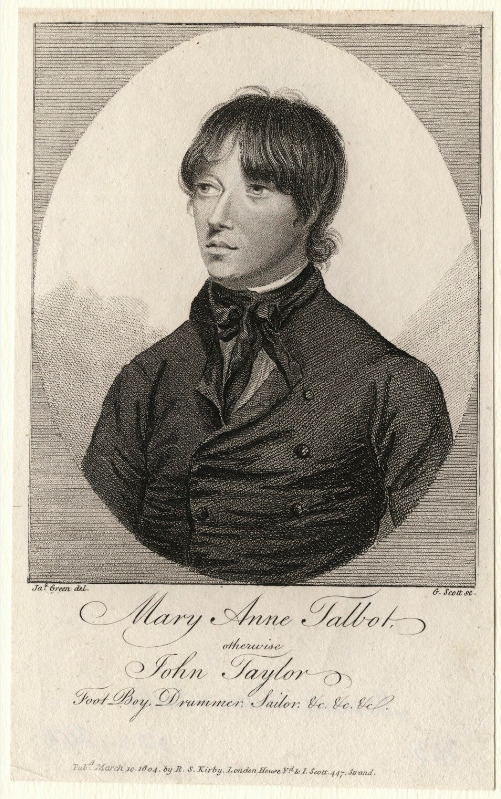
Mary Anne Talbot, by G. Scott, after James Green, published 1804 (x)
Perhaps some of you have noticed that there are certain similarities to Hannah Snell. And in fact, her story is very much in doubt. Because there are great inconsistencies with the times and the ships that she had given in her biography. Because there is no Talbot on the ships listed and there was no Talbot on the Vesuvius at the time it was captured, and the capture itself is also questionable because the ship was not off Normandy at that time but in the West Indies. Whether she just mixed things up here or whether they were chosen to spice up her story is questionable, and it cannot be ruled out that this story was a product of fantasy.
#naval history#mary anne talbot#female soldier and sailor#late 18th -early 19th century#women at sea#age of sail
70 notes
·
View notes
Note
I've been reading over your posts about Hamilton's relationships with other Federalists of the time. What about Nicholas Fish? He came from an old New York family, he studied alongside Troup & Hamilton, served with Ham at Yorktown (he even made Trumbull's painting!), remained close to him the rest of his life, became the first Adjutant General of New York, may or may not have broken a girl's heart, and continued a line of illustrious Fishes.
But beyond that...? Crickets.
Fish's and Hamilton's relationship seems to be one of the lesser known of Hamilton's notable friendships. Not much is known about their friendship due to only four letters of correspondence surviving (Likely burned by Fish for privacy), but they seemed to have had a life long friendship. And even after Hamilton's death, Fish remembered him as an honorable and beloved friend.
Nicholas Fish (1758-1833) was born into a relatively wealthy, New York, family. He attended Princeton but left before graduating to start studying law at King's College (Columbia University) through the office of John Morin Scott in New York. There he became interested in the organization of the Sons of Liberty (They were a loosely organized, clandestine - sometimes violent - political organization active in the colonies founded to advance the rights of the colonists and to fight taxation by the British government). Fish lived in New York City until 1774, then spent about a year in New Jersey before returning to New York in 1775.
During Hamilton's first months at King's, he and fellow classmate, Robert Troup, formed a club that gathered weekly for debating, writing, and speaking skills. The other members were; Fish, Edward Stevens, and Samuel and Henry Nicoll. Who were all relatively Hamilton's first and closests companions. The debates usually evolved around topics surrounding the brewing revolution, like monarchy and democracy. He also joined the volunteer militia group, The Hearts of Oak (Originally coined The Corsicans), alongside Hamilton and Troup. The students drilled before classes each morning in the churchyard of nearby St. Paul's Chapel. Their drillmaster was Edward Fleming, who had despite having served in a British regiment and married into the prominent De Peyster family but was still warmly attached to the American side. Fish once recalled;
Immediately after the Battle of Lexington, [Alexander Hamilton] attached himself to one of the uniform companies of militia then forming for the defence of the country by the patriotic young men of this city under the command of Captain Fleming, in which he devoted much time, attending regularly all the parades and performing tours of duty with promptitude and zeal.
Source — Alexander Hamilton, by Ron Chernow
In 1776 Fish was appointed by Brigadier General Scott aide-de-camp on his staff. On the 21st of August, 1776, Fish was appointed major of the 2nd New York Regiment. He served as a division inspector under Baron von Steuben in 1778. According to Fish, Hamilton had a direct hand in prodding Marquis de Lafayette to advocate bringing a French army to America. Before Admiral Jean Baptiste d’Estaing came with his fleet in July 1778, Hamilton encouraged Lafayette with ideas like having a French ground force with Lafayette as its commander. “The United States are under infinite obligations to [Lafayette] beyond what is known,” Hamilton told Fish later, “not only for his valour and good conduct as major general of our army, but for his good offices and infliuence in our behalf with the court of France. The French army now here [...] would not have been in this country but through his means.” [x]
He participated in the battles of Saratoga and Monmouth, in Sullivan's expedition against the Native Americans in 1779, and in the Virginia and Yorktown campaigns, in which he served for a time on the staff of Lafayette. Fish had shared a tent with Hamilton at Yorktown and recalled Hamilton bursting in gleefully after visiting Washington, hearing that he had won the coveted assignment, Hamilton hugged the surprised Major, shouting; “We have it! We have it!” [x] Although the two mostly went their separate ways during the war, Hamilton appointed Fish as his second-in-command. He commanded Hamilton's New York Battalion in the Assault on Redoubt 10 when Hamilton was given overall command of three battalions led by Gimat, Fish, and Laurens. To which, Hamilton was quite pleased about, writing to Eliza in August; “Major Fish is with me. I prize him both as a friend as an officer.” [x]
He is portrayed in the painting of the Surrender Of Lord Cornwallis, by Trumbull, standing behind Hamilton, Laurens, and Stuart.
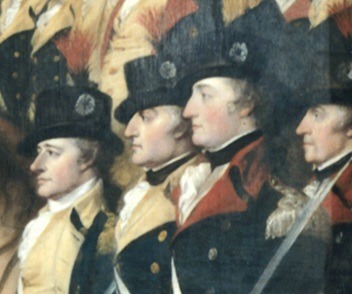

In the March of 1782, Hamilton and Eliza would have been trying to settle down in their first real home together in Albany, leaving the Schuyler Mansion where they had initially lived after Hamilton resigned from war. Hamilton wrote to Fish saying; “Send my horses by return of the bearer, unless they should be in too bad plight to travel. In this case, be so good as to put them out where they will be taken care of, and at the same time will not cost much for keeping.” [x]
In 1786, Fish was appointed Adjutant general of New York State, which he held for many years. Fish was also part of the Manumission Society, where many familiar faces were as well; Troup, Hamilton, Hercules Mulligan, William Livingston, John Rodgers, John Mason, James Duane, John Jay, and William Duer. The founding of the Manumission Society and antislavery societies in other states in the 1780s represented a hopeful moment in American race relations, right before the Constitutional Convention and the new federal government created such an overriding need for concord that even debating the divisive slavery issue could no longer be tolerated.
In 1794, he was appointed by Washington supervisor of the Federal revenue in New York City. In August, when the Hamiltons' then youngest son, John Church Hamilton, had fallen worryingly ill but started to recover—Hamilton sent his wife and child to New York City, where they remained under the watchful care Fish and Elisha Boudinot;
If you have not already left Albany write to me the precise day you will certainly leave it; so that I may meet you at New Ark. When you get to New York apply to Col Fish to make an arrangement for carrying you & the Child to New Ark & when there, go to Mr. Boudinot’s till I come.
Source — Alexander Hamilton to Elizabeth Hamilton, [August 21, 1794]
July 18, 1795, Hamilton was publicly criticized over his defense of the Jay Treaty at a meeting in New York. Hamilton tried to intervene in an argument between Commodore James Nicholson - who had smeared Hamilton months earlier - and Federalist lawyer, Josiah Ogden Hoffman. Nicholson was one of Hamilton's most prominent critics, and the two had long-standing political disagreements. When Hamilton came between the quarrel, Nicholson then allegedly called Hamilton an “Abettor of Tories” and accused him of declining a previous challenge to duel. “No man could affirm that with truth,” Hamilton retorted, and he “pledged himself to convince Mr. Nicholson of his mistake” by calling him to a duel at a more suitable time and place. [x] With Fish having drafted as his second, on the 20th he delivered the challenge letter to Nicholson;
The unprovoked rudeness and insult which I experienced from You on Saturday leaves me no option but that of a meeting with You, the object of which You will readily understand. I propose to You for the purpose Pawlus Hook as the place and monday next eleven o’clock as the time. I should not fix so remote a day but that I am charged with trusts for other persons which will previously require attention on my part. My friend Col. Fish who is to deliver You this will accompany me.
Source — Alexander Hamilton to James Nicholson, [July 10, 1795]
Nicholson immediately scratched out a reply, accepting the duel with that he would “certainly not decline your invitation” and asking that it take place the next morning; “The publicity of the affair & the unusual visit of your friend have however unfortunately occasioned an alarm in my family & may produce an inquiry—you will therefore perceive that my situation will be rendered extremely disagreeable unless our interview takes place before that time. I have therefore to intreat that it may not be postponed longer than tomorrow Morning.” [x] Eventually, on the 26th, after Hamilton and Nicholson had gone through three drafts of apologies (Hamilton being the one who wrote them for Nicholson's review), Nicholson signed a declaration apologizing for his conduct;
Mr. Nicholson declares that the warmth of the expressions which he recollects to have used to Mr. Hamilton proceeded from a misapprehension of the nature of his interposition in the altercation between Mr. Hoffman & Mr. Nicholson that as to the suggestion alleged to have been made by Mr. Nicholson namely that Mr. Hamilton had declined a former interview he does not recollect and is not conscious of having made it, neither did he intend the imputation which it would seem to imply and that if he did make the suggestion he regrets the pain which it must have occasioned to Mr. Hamilton.
Source — Drafts of Apology Required from James Nicholson, [25–26 July 1795]
The seconds representing Hamilton and Nicholson were DeWitt Clinton, Nicholas Fish, Rufus King, Brockholst Livingston. Once Nicholson and Hamilton agreed on the apology, they signed off on the following statement, thus ending the challenge in a “satisfactory and honorable way”.
In 1803, Fish married Elizabeth Stuyvesant (1775–1854), the daughter of Petrus Stuyvesant and Margaret Stuyvesant. They had five children together. On two separate occasions, Fish ran for United States Congress, and was unsuccessful. Losing to Samuel L. Mitchill in 1804 and Gurdon S. Mumford in 1806. In the week preceding Hamilton's mortal duel, Hamilton invited seventy people to the Grange for a lavish ball that included John Trumbull, Robert Troup, Fish, and William Short, Jefferson’s onetime secretary in Paris. John Church Hamilton recalls the event in his biographies of his father;
To reciprocate the attentions of his friends in a manner which, though novel here, he believed would most gratify, he gave, in the season of flowers and early fruits, a fete champetre. All that could please the modest taste of those simple days of wise frugality, was present. At distant points in the several copses were heard by sauntering groups the sounds of the horn and the clarionet, while his mansion was joyous with dances and repasts. On one of the piazzas were beheld some of his earliest, nearest friends, tracing the distant outlines of the variegated landscape of hill and dale, ocean and rivers; Hamilton standing by, chatting with Colonels Fish and Troup. Never was the fascination of his manner more remarked; gay or grave, as was the chanced topic, like the light and shade of a fine painting.
Source — Life of Alexander Hamilton, by John Church Hamilton · 1879
When the coming duel began to approach, on the 9th of July, Hamilton drafted his will at his last Manhattan town house. He named John B. Church, Fish, and Nathaniel Pendleton as executors;
In the Name of God Amen! I Alexander Hamilton of the City of New York Counsellor at Law do make this my last Will and Testament as follows. First I appoint John B Church Nicholas Fish and Nathaniel Pendleton of the City aforesaid Esquires to be Executors and Trustees of this my Will and I devise to them their heirs and Assigns, as joint Tenants and not as Tenants in common, All my Estate real and personal whatsoever and wheresoever upon Trust at their discretion to sell and dispose of the same, at such time and times in such manner and upon such terms as they the Survivors and Survivor shall think fit and out of the proceeds to pay all the Debts which I shall owe at the time of my decease, in whole, if the fund shall be sufficient, proportionally, if it shall be insufficient, and the residue, if any there shall be to pay and deliver to my excellent and dear Wife Elizabeth Hamilton.
Source — Last Will and Testament of Alexander Hamilton, [July 9, 1804]
Four years after Hamilton's death, Fish named his only son after his old college friend; Hamilton Fish (1808–1893), who served as New York Governor, United States Senator, and who married Julia Ursin Niemcewiez Kean (1816–1887).
Then again, Fish also twice ran unsuccessfully for Lieutenant Governor of New York. In 1810, he was the Federalist candidate, but lost to incumbent John Broome. Broome subsequently died one month into his term in August 1810. Fish ran in a special election for Lieutenant Governor in 1811 to fill the vacancy created by Broome's death, but lost to the then-mayor of New York City, DeWitt Clinton. During the War of 1812, Fish served as a member of the City Committee of Defense.
When Eliza was interviewing all the men that fought besides Hamilton to preserve his memory, Fish wrote a lengthy reminiscent letter to her in 1822, which I transcribed here (For whatever reason Tumblr keeps bugging out everytime I try to write it here).
Fish died in 1833, and was buried in the churchyard of St. Mark's Church in-the-Bowery in New York City.
Hope this helps.
#amrev#american history#american revolution#alexander hamilton#historical alexander hamilton#nicholas fish#history#queries#lookingforaham#cicero's history lessons
26 notes
·
View notes
Text

“Outside in the forest there was deep snow. The white snow had crusted the branches of the pine trees, and piled itself up them till they bent under its weight. Now and then a snow-laden branch would bend too far, and huge lumps of snow fell crashing to the ground under the trees. Then the branch would swing up, and the snow covered it again with a cold white burden. Sitting in the hut you could hear the crashing again and again out in the forest, as the tired branches flung down their loads of snow. Yes, and now and then there was the howling of wolves far away.” (Old Peter's Russian Tales; Arthur Ransome)
Born in Leeds, on January 18, 1884, Arthur Michell Ransome CBE, was an English author and journalist, best remembered perhaps for writing and illustrating the Swallows and Amazons series of books about the school-holiday adventures of children, mostly in the English Lake District and the Norfolk Broads.
Arthur was educated in Windermere, then at Rugby School, (where he lived in the same room that had been used by Lewis Carroll); completing his education by studying chemistry at Yorkshire College (now the University of Leeds), where his late father, Cyril Ransome, had been professor of History.
Arthur's broader journalistic topics included writings about the London literary scene of the day; also Russia before, during, and after the revolution of 1917. His connection with the leaders of the Revolution, leading him to provide information to the British Secret Intelligence Service; though MI5 actually suspected him of being a Soviet spy.
Arthur's other writings included books of biography and literary criticism on authors such as Edgar Allen Poe (published in 1910), and Oscar Wilde (1912); the latter embroiling him in a libel suit with Lord Alfred (Bosie) Douglas. Ransome won the suit, supported by Robbie Ross, bankrupting Douglas; though he removed the offending passages from the second edition of his book, and refused all interviews, despite the obvious publicity value.
Interestingly, although MI5 declared themselves satisfied with Ransome's loyalty to Britain by 1937, KGB files that were opened following the end of the Soviet Union in 1991, suggest that Evgenia Ransome (Ransome's second wife), at least, was involved in smuggling diamonds from the USSR to Paris to help fund the Comintern; a proposition examined in the 2009 book The Last Englishman; the Double Life of Arthur Ransome, by Roland Chambers
Arthur died in Cheadle Royal Hospital, on June 3, 1967. He and Evgenia rest in the churchyard of St Paul's Church, Rusland, in Cumbria, in the southern Lake District.
*
Old Peter's Russian Tales: a collection of Russian and Ukrainian folk-tales, retold by Arthur Ransome (published in Britain in 1916); the book said to owe its existence to Ransome's visit to the Russian Empire in 1913, partly to learn the language, partly to escape from his first marriage.
In Ransome's words: “The stories in this book are those that Russian peasants tell their children and each other. In Russia hardly anybody is too old for fairy stories, and I have even heard soldiers on their way to the war talking of very wise and very beautiful princesses as they drank their tea by the side of the road. I think there must be more fairy stories told in Russia than anywhere else in the world. In this book are a few of those I like best. I have taken my own way with them more or less, writing them mostly from memory. They, or versions like them, are to be found in the coloured chap-books, in Afanasiev's great collection, or in solemn, serious volumes of folklorists writing for the learned. My book is not for the learned, or indeed for grown-up people at all. No people who really like fairy stories ever grow up altogether. This is a book written far away in Russia, for English children who play in deep lanes with wild roses above them in the high hedges, or by the small singing becks that dance down the gray fells at home. Russian fairyland is quite different. Under my windows the wavelets of the Volkhov (which has its part in one of the stories) are beating quietly in the dusk. A gold light burns on a timber raft floating down the river. Beyond the river in the blue midsummer twilight are the broad Russian plain and the distant forest. Somewhere in that forest of great trees—a forest so big that the forests of England are little woods beside it—is the hut where old Peter sits at night and tells these stories to his grandchildren.”
5 notes
·
View notes
Photo
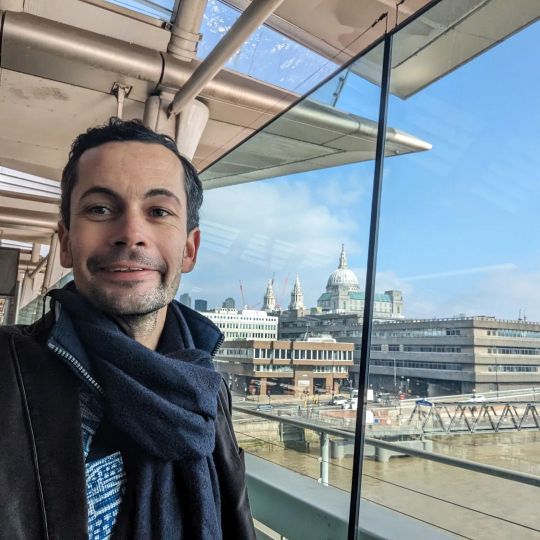
St Paul's Cathedral is an Anglican cathedral in London and is the seat of the Bishop of London. The #cathedral serves as the mother church of the Diocese of London. It is on Ludgate Hill at the highest point of the City of London and is a Grade I listed building. Its dedication to Paul the Apostle dates back to the original church on this site, founded in AD 604. The present structure, dating from the late 17th century, was designed in the English Baroque style by Sir Christopher Wren. Its construction, completed in Wren's lifetime, was part of a major rebuilding programme in the city after the Great Fire of London. The earlier Gothic cathedral (Old St Paul's Cathedral), largely destroyed in the Great Fire, was a central focus for medieval and early modern #london , including Paul's walk and St Paul's Churchyard, being the site of St Paul's Cross. (à Saint Paul's Cathedral) https://www.instagram.com/p/Cp-uqrWLDg3/?igshid=NGJjMDIxMWI=
2 notes
·
View notes
Text
Oxfordshire churches - North Moreton

I popped into North Moreton church in Oxfordshire today on my way back from teaching in Oxford. The medieval stained glass in the East window of the side chapel is old, put in by Miles de Stapleton in 1299. Miles died at the battle of Bannockburn - is the window below perhaps an image of him?
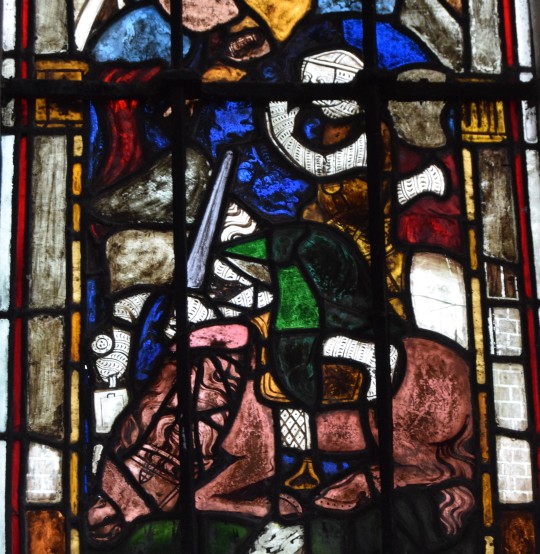
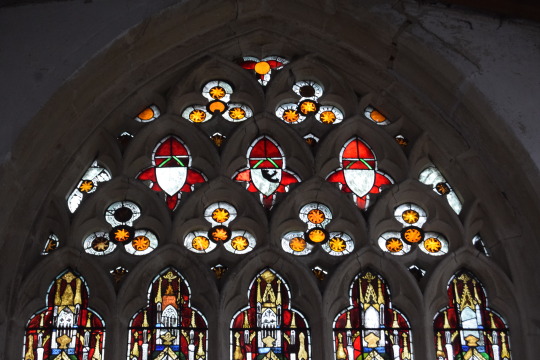
The windows are jumbled in places and have quite a bit of damage, it is suggested perhaps deliberately by Cromwell’s soldiers, as it is mainly the faces which are lost, as in this crucifixion scene:
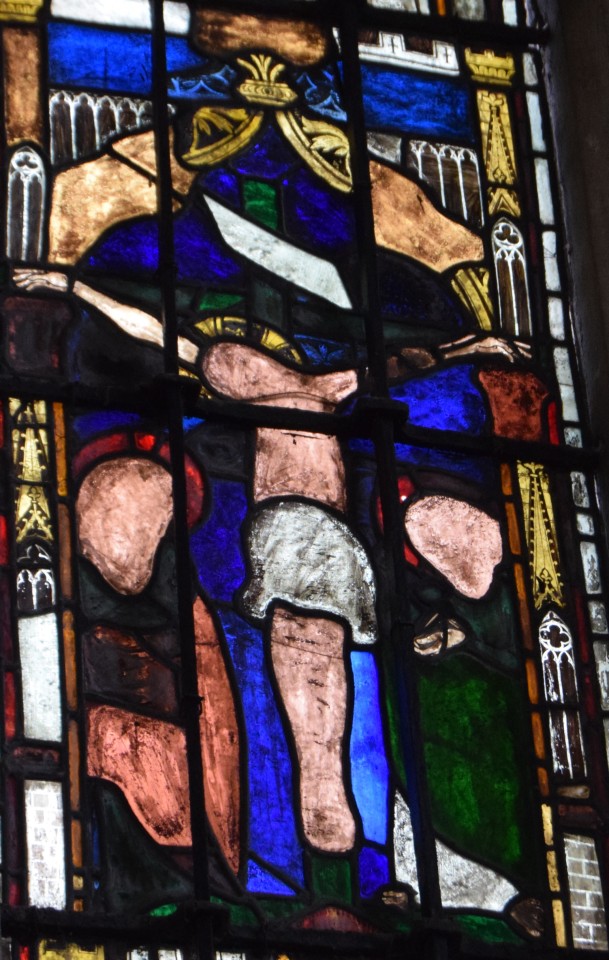
Nevertheless the colours are bright, and the figures have all the dynamism of early medieval art. The five traceries tell the story of St Nicholas, St Peter, St Paul, the Virgin Mary and Jesus. We have St Nicholas and the pickled boys:
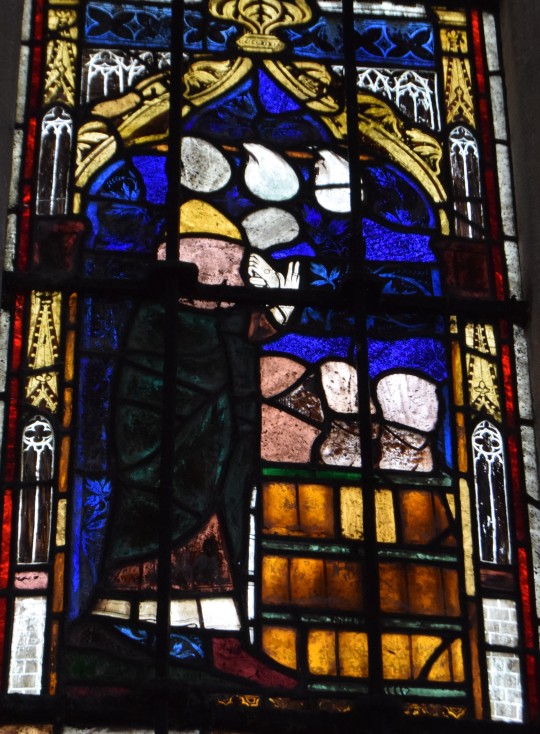
There does seem to quite a focus on the gruesome, as there is also the beheading of St Paul, and St Peter being crucified upside down. Perhaps Miles’s military experience fostered this.
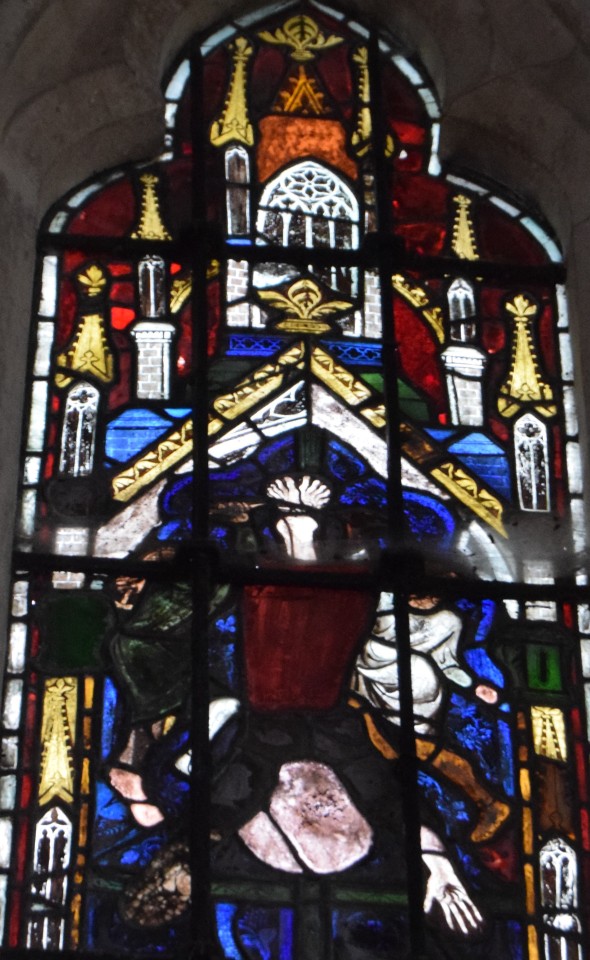
There is an eloquent crucifixion in another window in the church:

Outside, all is serene with two massive yew trees in the churchyard and an array of old houses:
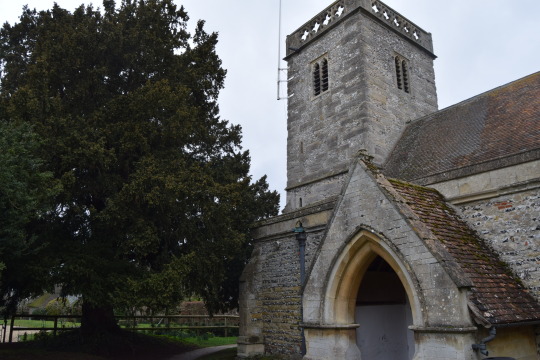
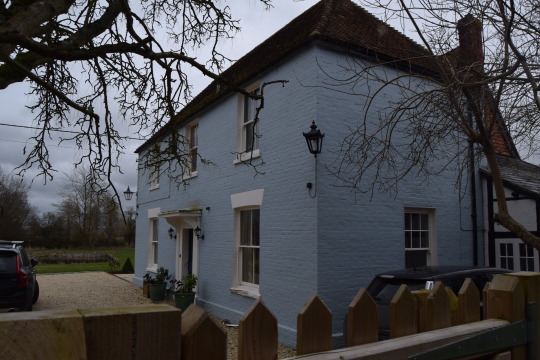
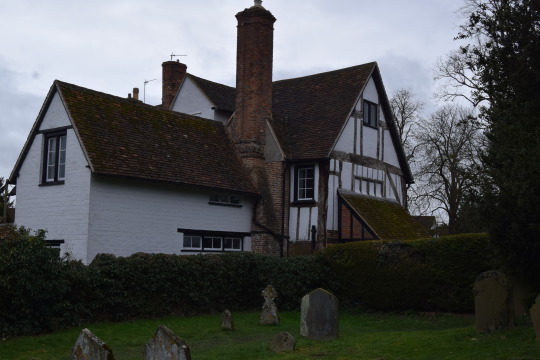

2 notes
·
View notes
Text
Mousehole, Cornwall’s Loveliest Fishing Village

Mousehole was hailed by Welsh poet Dylan Thomas as the "loveliest village in England," a phrase that still holds true today. Mousehole, pronounced 'mowzel,' is a sleepy fishing hamlet in Cornwall with a peaceful port where boats bob gently while the mellow sun warms the sand. Beyond the sheltered port, the rest of the hamlet spreads out with its classic granite houses, all embodying a rich past and old-fashioned charm that has been meticulously preserved to this day. Here are a few attractions near its port and its inner village bounds that are worth exploring.
Dolly Pentreath House and Grave
Not so much an attraction as it is a local gem, this house on Brook Street honors the memory of Dolly Pentreath or Dorothy Pentreath, the last native speaker of the Cornish language. The house is an old stone cottage with a plaque adorning its facade that informs passersby about its former resident. You can also travel to a small churchyard in the neighboring village of Paul to visit Dolly’s grave—a modest tombstone memorial that harks back to Mousehole’s early roots.
Mousehole Cafes
Mousehole may not have a vibrant nightlife near its main town, but it does have quiet and serene cafes providing delectable Cornish delights with warm cups of tea.The Old Pilchard Press Cafe is the place to go to for warm homemade scones served with a side of clotted cream and jam and accompanied by a Cornish cream tea. The Victoria Sponge, a delicate pastry that pairs perfectly with coffee, deserves special mention. All of this is served in a small, brick-walled setting brimming with Cornish charm.
Another hidden gem in Mill Lane is the Four Teas Cafe, which serves traditional British fare including fish pie and cake.
The charming Rock Pool Cafe, a beautiful little sanctuary by the sea that serves everything from Newlyn crab sandwiches to Cornish cream tea and cakes, is the finest place to truly experience Mousehole's peaceful coastal scenery. Its patio is the highlight, a lovely sun trap with views of St Michaels Mount and St Clements Island.
Art Galleries
Mousehole's allure extends beyond its gastronomic and heritage attractions. It is also home to a lovely artistic community that nurtures local artists. The Little Picture Gallery on Abbey Place represents a number of Cornish artists and is an excellent source for traditional art prints for your home or workplace. The Mowzer Gallery is a similar arthouse that is housed within a lovely little vintage brick structure and displays mixed media artworks.
Mousehole Wild Bird Hospital Sanctuary
The Mousehole Wild Bird Hospital, located on Raginnis Hill, cares for both land and seabirds, rehabilitating them until they can fly free. You can visit this sanctuary for free all year. Learn about the wonderful work that these volunteers undertake and leave a little donation if you choose!
Neighboring Villages
If you like quaint towns, you can make exciting day trips to the market town of Penzance and the pottery town of Marazion located near Mousehole.
Author Name
Advaita Raut
0 notes
Text
~Mr Azira Phale, Angel~
It struck me during the church scene that perhaps the Germans were calling him Mr. Fell because they thought Phale was his last name. So, I took a closer look at the two halves that made the whole.

~Azira
...Arabic in origin, it means A Rising Star. Interestingly, Pre-Islamic Arabia practiced Vedic religion, and in Vedic Astrology, Azira is a common name for babies born within Krittika Nakshatra, the older name of the Pleides Constellation.
Krittika..."literally means a "sharp flame" or "sword of fire." Alternatively, the word "Krittika" may be derived from the Sanskrit root krit, which means "to twist threads" or "to wind as a snake." This clearly is related to the symbology of the Caduceus and the May Pole.
The root 'krit' also means "to separate, cut asunder, or divide." This secondary meaning refers to the division of souls into two groups that occurs on the Day of Illumination. The subtle energy associated with the Pleiades constellation is considered a Sword of Fire because it cuts asunder or separates knowledge from ignorance. It separates light from darkness."

~Phale
The name is actually of what is known as Pictish-Scottish origin. "The Picts were a confederation of Celtic language speaking peoples who lived in what is today eastern and northern Scotland during the Late British Iron Age and Early Medieval periods. Where they lived and what their culture was like can be inferred from early medieval texts and Pictish stones. Their Latin name, Picti, appears in written records from Late Antiquity to the 10th century."
"This interesting surname is of Scottish and Irish origin, and it is an Anglicized form of the Scottish Gaelic "MacPhail", and the Irish Gaelic "MacPhoil", both patronymics from the Gaelic forms of the given name Paul, derived from the Latin "Paulus, meaning "small", and is has always been popular in Christendom."
Now of special note is Paul, the Saint, originally Saul of Tarsus, considered by many to be the actual founder of early Christianity, who very much believed in Angels, spoke of them appearing to him, and who at first, was bent on persecuting Jesus, only to become an Apostle after he appeared to him in the famous story of his travels on the road To Damascus. I came across an eye-opening article, theorizing that not only were Paul's writings edited and twisted, making him a patriarchal misogynist, but that he in fact believed in equality, was hugely inspired by Plato, and may very well have been Gay.
From: The (Possibly) Gay, Elite Apostle Who Believed in Radical Equality for All by Jay Parini
"I tend to agree with Bishop John Shelby Spong, a brilliant theologian and church leader, who argues that Paul was “a rigidly controlled gay male,” as he writes in Rescuing the Bible from Fundamentalism (1991). Be this as it may, Paul was clearly at war with his own body, tormented by the idea if not the reality of sexual desire, and eager to withdraw into the company of his male companions: Luke, Timothy, Silas, and others. His conflicted feelings about his own sexual nature may account for the “thorn in his flesh” that he wrote about in his second letter to the church at Corinth. (2 Corinthians 12:7-9)"

Galatians 3:28: “In Christ there is neither Jew nor Gentile, neither slave nor free man, neither male nor female. In Christ, all of these are one.” ~Saint Paul~
Saint Paul was later decapitated by Nero! Oh, and one last thing...
Azira is actually a girl's name.

BUT WAIT...THERE'S MORE.

For those who have looked closer, you may have discovered that Petronius worked for Nero.
Petronius was chief advisor to Nero and helped with the planning of all debauchery, orgies, feasts and crimes. He was known as Arbiter of Taste.
And Petronius wrote the infamous Satyricon.
Influence Of The Satyricon Upon The Literature Of The World.
"...It is to the author's recognition of the importance of environment, of the vital role of inanimate surroundings as a means for bringing out character and imbuing his episodes and the actions of his characters with an air of reality and with those impulses and actions which are common to human experience, that his influence is due...This class of literature, though modified essentially from age to age, in keeping with the dictates of moral purity or bigotry, innocent or otherwise, has come to be the very stuff of which literary success in fiction is made. One may write a successful book without a thread of romance; one cannot write a successful romance without some knowledge of realism; the more intimate the knowledge the better the book.."
"Petronius writes cynically and satirically about Roman decadence, about a society that’s corrupt and materialistic. Paul, to a certain extent, is writing about the same thing. He is certainly not humorous most of the time; he’s expressing his straightforward outrage about what he is seeing around him."
Petronius, set up for a treason charge by a rival, was threatened with death but chose to take his own life in quite a dramatic fashion, which is described in the notes to Satyricon. He died a year before Paul.
*Satyricon is compared often in style to Au Rebours by Joris-Karl Huysmans, and one translation published in Paris,1902 has been attributed to Sebastian Melmoth aka Oscar Wilde.
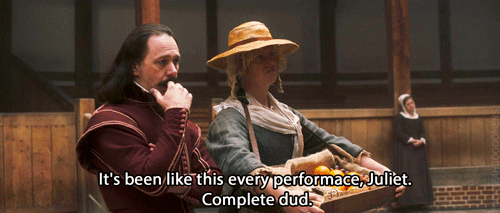
Now, was St. Paul an influence in any way on Shakespeare? The Bard of course wrote about Religion and Politics in his plays but due to his enormous influence, St. Paul managed to touch Shakespeare's place in a much different way. This has led to the discovery of a place I had never heard of from this time period...and a new head canon.
During Shakespeare’s lifetime, the area around old St Paul’s Cathedral was a hive of activity and industry...the main gathering place for acquiring (and spreading) news and gossip, purchasing the latest fashions and commodities, and, of course, for being seen. Under its Nave, as known as Paul's Walk, while the people who went there and into the churchyard were known as Paul's Walkers.
Complaint of Thomas Dekker in 1608:
‘What swearing is there; yea, what swaggering, what facing and out-facing? What shuffling, what shouldering, what jostling, what jeering, what biting of thumbs to beget quarrels, what holding up of fingers to remember drunken meetings, what braving with feathers, what bearding with mustachios, what casting open of cloaks to publish new clothes.’

Indeed, with its dozens of booksellers, Paul’s Churchyard was the centre of the London book trade, and was popular throughout the entire country.
"Booksellers on Paternoster Row became a source of competition in the latter half of the century, eventually winning the prominent position in London bookselling, but Paul’s maintained its supremacy well into the seventeenth century." This link has a beautiful rendering that can be expanded to show the individual publishers."
I imagine Aziraphale would have spent hours here, likely with Crowley beside him, eagerly pouring over the thousands of books available, excitedly meeting other writers, getting lost among a mixture of saints and sinners, just enjoying humanity. And I head canon that THIS is what gave Aziraphale his idea to open a bookshop.
What kept bringing me back to St. Paul?
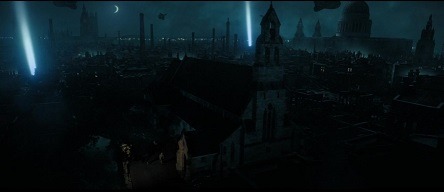
It's imposing presence caught my eye during the WW2 sequence. Turns out, it was bombed during the last days of December 1940, but survived due to the hard work of British firefighters.

“There are a lot of secrets in the design—a lot of buried subliminal stuff,” he reveals, noting that he hopes an eagle-eyed fan will find all the Easter eggs in Good Omens." Michael Ralph, Production designer, who also says that he based Azira's bookshop on the design of a compass.
Purposeful or no, using St. Paul as a guide through Good Omens has been a fun history lesson.
@consulting-nerd-of-many-things @ineffable-janthony @feifeicuttie @sarahthecoat @honeybeelullaby @echosilverwolf @englandwouldfalljohn@thegoodomensdumpster @fuckyeahgoodomens @artfulkindoforder @iamjohnlocked4life @artemisastarte @fellshish @brilliantorinsane
The Satyricon
https://www.uscatholic.org/church/scripture-and-theology/2012/04/putting-paul-his-place
The Influence of St. Paul on Shakespeare
An awesome podcast That Shakespeare Life on St. Paul's Bookshops
x x x x x x
#Aziraphale#Name Origin Meta#St. Paul#Founder of Christianity#Bible Studies#Arabic Origin#Vedic Astrology#Good Omens#1st GO Meta#aka DymphnaSaints#TRMOJAS#shakespeare#Old St Paul's Churchyard#Paul's Walkers#WW2#I wish someone would include the churchyard in a film or documentary
99 notes
·
View notes
Photo
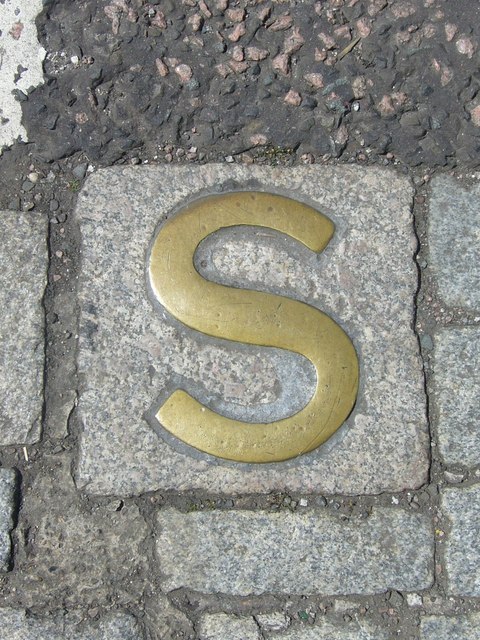
Sanctuary marker for Holyrood Abbey.
A series of three shiny brass letters mark the boundary of an old refuge for those being pursued by debt collectors. Within the sanctuary, those who were in debt could seek refuge from their creditors. Here, food and housing were provided, though at a substantially higher rate than could be found in the walled city of Old Town. But more importantly, the sanctuary prevented creditors from being able to harass and haul these poor souls off to the Tollbooth Gaol.
I don't know why, but this tale popped up in my "anniversary" alerts, it tells the wonderful things believed in by our ancestors, this relates to a man who was able to "Fast" for extraordinary long times.
About the year 1531, one John Scott, a Teviotdale man, attracted attention in Scotland by his apparent possession of the ability to fast for many days at a time. Archbishop Spottiswood gives an account of him. ‘This man,’ says the historian, ‘having succumbed in a plea at law, and knowing himself unable to pay that wherein he was adjudged, took sanctuary in the abbey of Holyrood-house, where, out of a deep displeasure, he abstained from all meat and drink the space of thirty or forty days together. Public rumour bringing this about, the king would have it put to trial, and to that effect, shutting him up in a private room within the Castle of Edinburgh, whereunto no man had access, he caused a little bread and water to be set by him, which he was found not to have tasted in the space of thirty-two days. This proof given of his abstinence, he was dimitted, and coming forth into the street half naked, made a speech to the people that flocked about him, wherein he professed to do all this by the help of the Blessed Virgin, and that he could fast as long as he pleased. Many did take it for a miracle, esteeming him a person of singular holiness; others thought him to be frantic and mad; so as in a short time he came to be neglected, and thereupon leaving the country, went to Rome, where he gave the like proof to Pope Clement the Seventh.
‘From Rome he came to Venice, apparelled with holy vestures, such as the priests use when they say mass, and carrying in his hand a testimonial of his abstinence under the Pope’s seal. He gave there the like proof, and was allowed some fifty ducats to make his expense towards the Holy Sepulchre, which he pretended to visit. This voyage he performed, and then returned home, bringing with him some palm-tree leaves and a scripful of stones, which he said were a part of the pillar to which our Saviour was tied when he was scourged; and coming by London, went up into the pulpit in St Paul’s churchyard, where he cast forth many speeches against the divorce of King Henry from Katherine his queen, inveighing bitterly against him for his defection from the Roman see, and thereupon was thrust into prison, in which he continued fifty days fasting.’
John Scott, the faster, is alluded to by his relative Scott of Satchells, an old soldier of the German wars, who, about 1688, drew up a strange rhyming chronicle of the genealogies of the Scotts and other Border families, which he published, and of which a new edition appeared at Hawick in 1784. The author plainly tells that he was
‘———- ane that can write nane
But just the letters of his name.
’and accordingly his verses are far from being either elegant in form or clear in meaning. Yet we can gather from him that the faster was John Scott of Borthwick, son of Walter Scott, of the family of Buccleuch, since ennobled.
Hearne states (Leland‘s Itinerary, vi., preface) that the story of John Scott, the fasting-man, was investigated with great care by Signor Albergati, of Bononia, and set down by him in a paper which is preserved, and of which he prints a copy. The learned signor affirms that he himself took strict means of testing the verity of Scott’s fasting power during the space of eleven days in his own house, and no fallacy was detected. He put the man into clothes of his own, locked him up, kept the key himself, and did not allow meat or drink to come near him. He ends the document, which is dated the 1st of September 1532, with a solemn protestation of its truthfulness.
19 notes
·
View notes
Text
Any Other Name- Chapter 3

Once the dishes were all dried and put away— dishes that didn't even belong to them, to begin with— and the kitchen cleaned, Cordelia helped Sona unpack a few more boxes of kitchen supplies and pack away some of the things that Tessa left behind. They labeled the boxes storage so no one would throw them away and tucked them into the empty hall closet.
When it was only half an hour to ten, the Inquisitor and Consul finally left, leaving the Carstairs family once again alone in the house that felt nothing like home.
At some point during the hour and a half discussion spent inside of the study, her father had loosened his tie, abandoned his jacket, and rolled his shirt sleeves up to his elbows. Dark circles etched around his eyes and a distinct shadow appeared along his jaw and neck flecked with silver amongst the black.
Cordelia stared at the door they’d just left through and silently sent a prayer to the Angel that they both died in a terrible, albeit ironic, accident on their way home.
“Well,” said her mother, her voice echoed in the empty foray. “What did they say?”
As much as Cordelia wanted to stay and listen to her father’s debriefing, she only had twenty minutes left to meet with Lucie and she still had no idea how to get to the location Lucie left her. She’d never ventured alone around London before and with all the buildings and streets and mundane vehicles, it might as well be a maze to her.
“I think I’ll wait to hear the overview over breakfast,” said Cordelia as she turned towards the stairs. “There is only so much nonsense the stomach can handle. Too much is just not good for the digestion.”
“Goodnight, sweetheart,” said her father. “Thank you for tonight. They were both quite impressed by you.”
With her back towards her parents, she rolled her eyes and ran up the rest of the stairs.
Once back inside Lucie’s bedroom, she peeled off the cotton dress and tossed it on the bed. She pulled on a pair of black jeans, a black long sleeve shirt, and her favorite leather jacket that she zipped up to her chin and flicked the hood over her head. She tugged on her combat boots and tucked in the laces before grabbing Cortana, a stele that she tucked into her inside jacket pocket, and a couple of daggers before she shoved open the window and climbed out on the roof.
A fine mist had started just enough to make everything wet. Cordelia’s rubber soles gripped the tiles as she snuck across the tile until she found the trellis that usually had delicate pink roses clinging to a climbing vine this time of year. It was long dead and fallen to the ground in a pile of brown sticks and thorns.
Cordelia hooked her foot into a hole in the trellis and began her descent; the toes of her boots taking purchase in every nook they could find until her feet landed in the flower bed outside of the now dark dining room window.
Cordelia shook the water from her hands and shoved them into her jacket pockets to keep them warm before heading out to the main road.
The rune her mother gave her before they portaled to London still burned and kept her invisible from the mundane eye and her relatively mundane clothes wouldn’t attract the attention of any Shadowhunters that might be out on patrol. As she strolled through Mundane London, which remained surprisingly bright and alive at almost ten at night, with loud vehicles motoring past on narrow roads, horns blaring, or someone’s obnoxious bass beating into the night, Cordelia found that in some ways it did remind her of the city in Tehran. When she’d go out on patrol with Hettie and Minu it would often look quite similar to London.
If she hadn’t been running late, she might have lingered to ogle at some of the buildings or traveled her preferred way over the rooftops. High above the crowds, where she could see the gabled peaks of St. Paul’s Cathedral and the moon glittering off the River Thames. But tonight she was short on time.
Once a few miles away from the Institute, Cordelia took out Lucie’s note and her stele and drew a tracking rune onto the sheet. It burned to life in her hand and flapped in an invisible wind. She followed its lead down Fleet Street until they reached the corner at Ludgate Hill and it tugged her down St. Paul’s Churchyard.
She had to run to keep up with the possessed page. Cordelia began to wonder if it was some cruel trick Lucie was playing on her as it turned down Cannon St, then Queen Victoria St, then Mansion House, and Cornhill. She nearly gave up when it took a slight left from Leadenhall to Aldgate when the bells of the old clock tower began to chime the hour.
She could see the clock now. Its round face was bright in the night and its ancient wooden structure looked decrepit as it titled slightly towards the left. The paper tugged itself stubbornly towards the tower nearly ripping itself out of Cordelia’s hand.
Cordelia tucked the paper back into her jacket pocket even as it continued to twitched and force itself out. She picked up a jog and jumped at the iron gate protecting the park where the old tower stood in the center. With little effort, she was able to clear the gate and land back on her feet on the other side.
The park was empty except for an oblivious security officer staring at his phone from his odd-looking golf cart. The angle of the phone and the light reflecting off his face gave him an unattractive double chin. She never wanted anything to do with mundane technology, it served as too much of a distraction. That mundane might as well offer himself to a demon for dinner. If Shadowhunters allowed themselves to be that vulnerable, there’d be far fewer of them.
Minu, she knew, would want to mess with him. Minu enjoyed teasing mundanes when given the chance, especially if what the mundanes were doing was dangerous and negligent.
But she didn’t have time to think about what Minu would do or that the security guard was distracted by his phone.
Cordelia walked the rest of the way to the clock and carefully ducked under the yellow caution tape surrounding it. By the burning runes etched into the wood, she knew it was glamoured. She wondered what it looked like to the mundane eye when they walked past.
Cordelia spun around looking for a shadow or a shape that might be Lucie waiting for her. She hoped she wasn’t too late and Lucie left.
“Lucie,” she whispered into the night. “Lucie, I’m here. Where are you?”
After a moment when the only sound that responded to her was a pigeon's coo, she circled the base of the tower until she found a back door propped open with a brick.
Never one to need a moment of courage, Cordelia took a deep breath to calm the tightening in her chest and opened the door on its senescent hinges.
A serpentine staircase twisted its way up the tower for what looked like miles where Cordelia stood. A few field mice scurried away to their burrows at the sudden intrusion, their droppings and mess littered the wood stairs that groaned under Cordelia’s weight as she started her slow ascent, testing each beam before trusting it. She skipped a few that bowed in the middle and those that were already missing and wondered how Lucie hadn’t fallen to her death climbing her way to the top.
London and their pride over their ancient structures, Cordelia thought to herself. It was no wonder the whole building had to be cautioned off. It would only take one idiotic mundane with a death wish to climb these and plummet to their doom.
She began to wonder what would happen if she were to fall and be found dead at the bottom of the tower. Surely she’d disgrace her family who would wonder what would bring her out to an abandoned old clock tower in the middle of the night. The Clave would think the reason was something scandalous most likely. One thing was for certain though, she’d become the Bridgestock’s personal poltergeist in her afterlife.
Nearly at the top now and clinging to the unreliable railing, she could see the light from the watch face and feel the reverberating beats of the mechanisms through the wood underneath her feet as each hand of the clock moved half an inch for each second.
Once at the top, the paper in her jacket pocket went still. She stepped into the empty room and took in her surroundings. The clock face was a window that looked out over London. She could see the points and peaks of Buckingham Palace and Big Ben’s watchful eye in the distance. The lights from Regent’s park lit up the night as well as the red and white traffic lights around King Cross station. She had to admit if only to herself, London was beautiful from up high. Looking down on it, she felt how Pip might have felt in Great Expectation. From down below, London appeared ugly, crooked, narrow, and dirty. But from up above, it represented the ultimate milieu in terms of success. The equivalent of civilization; a world where only the most successful go; a tireless city of possibilities; and a bit romantic.
“You came,” said a soft, familiar voice behind her. Cordelia turned, her hood dropping away from her face, as she faced Lucie standing in the dull shadow the clock face made on the floor. She held something in her hands pointed directly at Cordelia. It wasn’t a knife or a sword or even an ax-- Lucie’s preferred weapon-- but a gun.
“I didn’t think you’d come,” said Lucie, her hands steady. The barrel of the weapon never once dipped or swayed. “Give me your weapons.”
Cordelia raised her hands. “Lucie, I’m not here to hurt you—“
“Remove your weapons and toss them here,” said Lucie firmly. “I won't ask you again.”
Cordelia wasn’t sure if that meant Lucie would shoot her or leave if Cordelia refused, but she didn’t prefer either outcome. She removed Cortana first and laid it on the ground at her feet and kicked it gently towards Lucie. Then the duel blades from inside her jacket and her stele.
“Now remove your jacket and your boots,” said Lucie, eyes still locked over the barrel.
Cordelia unzipped her jacket and dropped it to the floor. Then she kicked off both of her boots and tossed them into the pile too.
“Put your arms out to your sides,” said Lucie as she took a step towards Cordelia, “and spread your legs.”
Cordelia did as she was told watching Lucie carefully as she approached, holding the gun in one hand now while the other quickly patted Cordelia down for any more hidden weapons.
“I’m clean.”
“Don’t speak,” said Lucie, feeling around in Cordelia’s pockets.
“I thought that was why you asked me to come here,” said Cordelia, as Lucie pushed the gun into Cordelia’s side and frisked both of her legs. “To talk.”
“Then why did you bring the weapons?” Lucie stood and took several steps backward once she was satisfied Cordelia had no more weapons.
“I’m a Shadowhunter, I brought them in case I needed to defend myself,” said Cordelia. “Why did you bring the gun?”
“For the same reason.” Lucie hissed.
“Guns don’t work on demons.”
Lucie’s gaze narrowed. “Not all of them.”
Cordelia dropped her arms back down to her sides and took a moment to appraise her friend— though she wasn’t so sure she could call her that anymore. She looked nothing like the girl Cordelia used to clash pretend swords with or make chains out of the wildflowers that would grow in the fields of Alicante when they’d visit during Spring. Her eyes changed in the five years since they last saw each other. Once wide, excited, and curious, they were now focused and on guard, like an expert gambler waiting for an opponent to show their tell, and lined in thick black ink that bled down to her lower lash line. She cut her mousy brown hair to her narrow shoulders where it curled in an uneven pattern, similar to her brother’s.
“Lucie, it’s me.” Cordelia exhaled and stepped forward.
Lucie pulled down the hammer on the gun until it clicked into place. “What nickname did my brother give you when we were children and why?”
A test, Cordelia understood. A question only the real Cordelia and not some imposter would know the answer to. “Daisy. He called me Daisy because when we were little girls we were playing and you fell from the edge of a cliff. I caught you and held you there until help came. James said that when they pulled you up, I collapsed from exhaustion into a pile of daisies.” Tears sprang to her eyes at the memory. “It’s me, Lucie. I’m not here to hurt you.”
The corner of Lucie’s mouth twitched right before she lowered the gun down to the floor and disengaged the hammer, her eyes never leaving Cordelia.
“I had to be sure,” whispered Lucie. “I’m sorry for being this way, but you have to understand the precautions are necessary. It’s incredibly dangerous for me and you to be here right now, but I had to speak with you and I knew that if anyone would be willing to meet with me, it would be you.”
Cordelia nodded and took a tentative step closer. “I understand. No need to apologize. How did this happen, Lucie?”
“Bridgestock finally got his way." She shoved her gun into its holster at her hip. “We can’t even use angelic weapons anymore. He had them be remade by the iron sisters so that they wouldn’t respond to anyone with even a little bit demon blood, the bloody tosser. It wasn’t enough that he stole our home, he had to take our one form of defense away.”
“That’s awful,” said Cordelia and looked down at the pile of weapons on the floor.
“He believes that we cannot be Shadowhunters because of our linage,” said Lucie.
“But why?” asked Cordelia. “It doesn’t make sense. Your family has never done anything to deserve this kind of treatment.”
“He believes our blood to be dirty,” sneered Lucie. “He always had something to say about my mother’s paternal side but he didn’t fight anyone on it until my mother became pregnant with James. Then, he really started to build his whole agenda around the purity of Shadowhunter blood. No one paid him any mind until James accidentally disappeared into the Shadowrealm in front of Augustus.”
“He what?!”
“It was an accident,” shouted Lucie. “Augustus was saying horrible things about my mother and James retaliated by punching Augustus in the face. When Augustus grabbed him to throw a punch, James just disappeared out of his grasp. Of course, Pounceby ran home to his father to tell him of the situation and that seemed to be the last straw. They gathered enough votes to remove Charlotte from her position as Consul and have us banished.
“No one cared that Augustus said my mother was nothing more than a Shadowhunter’s whore that my father knocked up on accident because he couldn’t keep his—“ Lucie shuttered and her whole face turned red. “He said some nasty things, but no one cared about that. No, they only cared that James’s demon blood gave him abilities that were not gifted by the angel. They didn’t want to risk anymore of the blood being passed on when James or I married, so they banished us. They fucking banished us.”
Cordelia fought the urge to run over and hug her. Even words failed her, what could she say that could fix any of this. To say “ I’m sorry” felt disingenuous because she wasn’t sorry, she was livid. She wanted to ask Lucie who she wanted her to murder first.
In the end, she decided to say nothing and let Lucie speak.
“It’s also partially punishment,” continued Lucie, “because my father continued to refuse Bridgestock’s and Pounceby’s advancements on the separation of Shadowhunters from Downworlders. Downworlders are also not from the Angel and therefore we should not have an alliance with them. We should govern and control them. He wants us to disassociate ourselves from our friends, Cordelia. He wants us to manage and control them like they’re beneath us. He wanted to strip them of their rights, rights that they earned from the truce created between us so long ago. He’s a dictator, Cordelia, and he’s going to start a war.”
Cordelia nodded. “I know. I agree. What can we do?”
Lucie closed her eyes and exhaled. “Nothing. He has the majority of the clave so wrapped around his finger that he can manipulate them to do his work like little marionettes.” She imitated the movements with her hands.
“What about your Aunt Cecily and Uncle Gabriel? Charlotte and Henry? Sophie and Gideon?” asked Cordelia. “They make up a large part of the Clave surely their opinions have some sway.”
“He threatened them,” said Lucie. “When they banished us at the Clave meeting, they told everyone that disagreed with the decision that they could be exiled as well and they would be forced to give up their Marks. Christopher, Matthew, and Thomas were willing to do it, but their parents stopped them and then forbid them from seeing James or me! Did you hear what they did to Matthew?”
Cordelia nodded and felt like she might be violently sick.
“I can still hear James screaming in my mind when they removed the mark from Matthew.” A far-off look washed over Lucie’s face. She squeezed her eyes shut in an attempt to erase whatever had taken over her vision.
“What about Brother Zachariah?” asked Cordelia. “Jem and the rest of the Silent Brother’s. Surely, they wouldn’t agree to this.”
“Brother Enoch’s exact words were ‘they do not doddle in the affairs of mortal men’.” Lucie rolled her eyes. “Just another way of saying it’s not their problem. We haven’t heard anything from Jem because to try to intervene would be going against his vows. We have been utterly abandoned.”
“No,” Cordelia stepped forward again until she stood only a few inches from Lucie. “I’m here. I won’t abandon you.”
“You can say that now but you haven’t been here the past six months,” said Lucie. “If anyone knew you came here to see me tonight you’d be publicly punished, possibly stripped of your Marks, or something worse. I shouldn’t have ever asked you to come. It was selfish of me, but I don’t have very many choices and you’re the only one that can help me with this.”
Without hesitation, Cordelia blurted, “What do you need from me? How can I help?”
“When you go to the next Clave meeting in Alicante, there is a book from the library there that I need you to find,” said Lucie. “It’s the first volume of the Shadow Codex ever written. You’ll most likely find it in—“
“I know where I can find it,” said Cordelia, the warmth from her skin drained. “Lucie, it’s forbidden to touch that book, you know that. It’s protected with wards and a glass encasement. It’s an ancient relic for us. To look at that book is a privilege; to touch— to steal it— would be cause for punishments we haven’t even heard of.”
“I know, I know,” said Lucie. “I wouldn’t be asking you this if I had any other choice. I can’t ask anyone else because they’re all constantly being watched by Augustus and his friends. You have less of an affiliation with us than anyone else. They won’t be watching you as closely and you’re incredibly clever.”
“Flattery will not work right now, Lucie,” said Cordelia as she began to pace. “What do you want with the Shadowhunter Codex anyway? What’s in the original that isn’t it one of the hundred volumes published for public access?”
Lucie averted her eyes. “I can’t tell you.”
Cordelia huffed. “Why not? If I’m to do this I deserve to know what I’m doing it for.”
“You’re doing it to help me and my family.” The hardness returned to Lucie’s gaze and tone as she looked back up to Cordelia. “If you believe what’s been done to us is wrong and needs to be stopped then you will help me with this, no questions asked.”
Cordelia let out a deep breath and tried to make sense of her racing thoughts. If she did what Lucie was asking and stole the very first Shadowhunter Codex written and illustrated by the first three then it wouldn’t just mean her punishment, but her family’s punishment as well. They’d be humiliated by her, disappointed, and possibly cast out. But if she wasn’t caught and within this book was a way to help save the Herondales and tear Bridgestock and Pounceby down from their reign of power, then the risk may be worth it… as long as she wasn’t caught.
“I’ll try,” said Cordelia. “I’m not promising anything and I’m not risking my own family, but you were a good friend to me when I had no one else, so I will try.”
Lucie’s eyes swam as she gave Cordelia a tentative smile. “Thank you.”
The shadow outline of the clock on the floor of the shack reflected it was forty-five minutes past the hour. She should be getting home for tomorrow she would be training with Augustus and she needed all of her sanity not to club him in the nose with the blunt end of Cortana.
“The meeting is going to be held in two weeks,” said Cordelia as she walked to her pile of clothes and weapons. “I will meet you back here on the Saturday that follows at the same time. If for some reason I don’t make it then it will be the next night or the following. If I don’t show up after three days then it’s safe to assume that I was caught and thrown in prison; in which case I hope that you find a way to win and take those bastards down.”
She shucked on her jacket and slid her feet into her boots.
“We were supposed be Parabatai,” said Lucie and handed Cordelia Cortana. “It would have been an honor. I would have been lucky to have a warrior partner like you.”
Cordelia took her sword from Lucie. “I still believe we will be. Until then, we will continue to treat each other as such.” She placed a hand on Lucie’s shoulders before turning towards the stairs and began her descent back into the night.
---------
A heavier rain began to fall as she made her way back towards Fleet Street. Cordelia pulled up her hood and shoved her cold, wet hands into the front pockets of her jacket as she walked, Cortana nudging her back with each step she took. The city had finally quieted some: the roads were less crowded except for the occasional bright yellow taxi.
Without Lucie’s runed letter to follow, all of the roads and buildings looked the same to Cordelia. She hadn’t exactly been paying attention to landmarks or street signs when she was following a possessed page down dark streets in corners. She did the best she could by memory but found herself growing less and less familiar with her surroundings.
It may have been her growing frustration with herself or her paranoia after seeing Lucie, but she couldn’t shake the odd sense that she was being followed. Though every glance she threw over her shoulder, she found nothing to be lurking in the shadows even with her night vision rune still burning on the inside of her arm.
She found herself wandering down a road that was still rowdy for this time of night. Flickering lights of red and yellow flashed from signs hanging over doorways where loud music and shouting filled the streets. The air smelt thick of spilled ale and magic. As she passed by, she could have sworn eyes followed her from the patrons standing outside of the clubs. She hid her face deeper within her tunic and tried to keep her gate casual to not draw attention to herself.
When she got to the end of the road, she took a right but found that it was a darkened alleyway that came to a dead-end only a few feet in. Frustrated, she turned around and nearly collided with a man.
No, not a man, a Fae warrior. His long black hair was tucked behind each of his pointed ears and when he flashed her a predatory smile sharp incisors glistened in the lights that lined the roof.
Cordelia regained her balance quickly and looked at him then the two other warriors standing on either of his sides.
“You’re a long way from your side of town, Nephilim,” he said in a deep gravely voice. “And all alone.”
“What makes you assume I’m alone?” said Cordelia, fighting to keep her voice even.
“We’ve been following you for the past half hour,” said the Fae. “You seem a bit lost.”
The Fae were not their enemy. She had nothing to fear from them, but for some unknown reason, she felt uneasy in their presence alone. Her hand itched to reach for Cortana, but to do so would show her apprehension and she didn't want to appear as a threat.
So she told them the truth. “I'm a bit lost. I’m new to London and my escort seems to have abandoned me. I’m looking for Fleet Street. Would you mind pointing me in the right direction?”
The Fae took a step forward, forcing her to take a step backward farther down the alley. “A Nephilim alone in our side of town is fair game. Perhaps we should make an example of her the way her kind make an example of us when we wander too far into their parts?”
The other two warriors grunted their agreement.
Cordelia did reach for Cortana then and with a sharp pull, removed the sword from its scabbard. “I don’t want to harm any of you. I’m here by accident and I’d like to leave without any unnecessary bloodshed. If you would kindly move, I will be on my way.”
The Fae warrior removed two blades from the scabbards at his sides and glided them across each other so they made a spark. “She is a lovely thing. Perhaps we could take turns with her and return her back to her people used.”
Cordelia swung Cortana and positioned herself to fight. “You can try, but I strongly advice you let me pass.”
“Or what?” grinned the head Fae. “You’ll cut all three of us down by yourself with that little blade in your hand?”
He moved towards her again, and this time Cordelia refused to give one step.
“Oh, I wouldn’t doubt her, Bevan,” said a voice from the opening of the alley. “I’ve seen her take down men twice as skilled as you.”
As the three Fae men turned to look behind them, Cordelia took her chance and lunged for the lead Fae.
A/N: Comments, likes, and reblog are my main source of motivation so please let me know what you think.
Next chapter comes out: Fri, June 11th.
#the shadowhunter chronicles#jordelia fanfiction#james x cordelia#james herondale#cordelia carstairs#the last hours#chain of gold#chain of iron#chain of thorns#alternative universe#shadowhunters#cassandra clare
14 notes
·
View notes
Text
Saturday 12 May 1838
7 25/..
1 25/..
dull morning F58° at 8 am felt cold – put on knee-caps again (had I not worn them yesterday or Thursday) and worsted stockings – all ready to be off and breakfast and off to Waterloo at 9 ½ - Calêche took Oddy and George – had not room for Lion – the forest of Soignies in process of down cutting – sold by the ex-king a little before the revolution to the Bank of Brussels (said our Waterloo guide) and now selling off by the Bank, to be turned into agricultural land – jolting pavé all the way made A-‘s back of neck bad – alight at the village of Waterloo at 11 10 opposite the little garden where the M. of Angleseys’ leg was buried – just go in and see the outside the building for which had afterwards to pay 0/50 – then our woman guide took us to the church and fetched the old man to let us in for which paid him 1/. the entrance end crowded with monuments to the English etc. etc. killed 16, 17 and 18 June 1815. one monument to the memory of 24 officers and 375 non commissioned ditto and privates of the 70th Highlanders – the M. d’ Anglesey here 2 years ago, and dined in the room where his leg was cut off, and sent the people a portrait of himself – from the church to the little churchyard the English officers buried in the middle in the avenue of limes – at entrance end of it, Sir Alexander Gordon buried aid de camp to the duke of Wellington who never comes without going to his grave – Sir Alexander was in the act of speaking to or had just been speaking to the duke when the cannon ball took him off – M. [Mise], banker of Brussels, has a chateau at Waterloo, and is the principal proprietor – In returning went into a café, en haut, for which gave ½ fr. asked for sols for a franc the full change for which the woman was reluctant to give me till she heard what she was to have for herself – then got into the carriage at 12 again opposite La poste a neat looking Inn where the duke of Wellington had slept, and drove off to the village of St. Jean and alighted (did not go in) at an auberge at 12 ¼ - there our man guide joined us, and there commenced our little tour – the man was one of 3 servants at the farm of St. Jean (aetatis 17 at the time – the master se sauvait) – where so many of the wounded were – the house and farm buildings and court yard full – passed this for some distance and then direct to the montagne de Lion, the great tumulus erected 7 years afterwards on the spot where the prince of Orange was wounded (in the shoulder) – the whole height 200ft. from surface of ground to top of bronze lion weighing 1048lbs. cast by Cokerill of Liège – the apex of the tumulus 100ft. diameter – conspicuous from far – ascended to the top by steps cut out in side of the embanked earth and faced with wood – 5 minutes ascending and 35 minutes at the top – enjoying the fine prospect (charming day – nor hot nor cold, nor wind, nor dust) and conning over our plan of the battle bought at St. Jean village of where we left the carriage – got a thorough understanding of the different positions and then at 1 35 down again and off to Hougoumont thus written by the duke of W- in his despatch from La belle Alliance, instead of château de Goumont, an easy mistake now perpetuated by the celebrity of the written and the writing – an English officer who had fought in the battle (of no great appearance) was on the mountain with a party of ladies and gentlemen while we were there – but from what I overheard our guide seemed the better of the 2 – the proprietor of the quondam chateau de Goumont, M. de Goumont, is now living in the neighbourhood of Brussels? did the man say – government bought the place of him and leave it as was after the battle as a monument of the battle – good taste – the then outbuildings form the present farm-house – the chateau (the chapel and well house remain) was burnt down and all the wounded as many or [more]
SH:7/ML/E/21/0096
French than English perished in the flames – the French under Jerome Buonaparte and General Foy finding they could not take this key of our position, set it on fire – the wood then close in front of the garden that made it so strong, is now cut down and turned into common ground – the place was at the time exceedingly strong undercover of this wood – the French had no idea of the strength of this position – the duke of Wellington arrived from Brussels in the morning of the 17th and took up this position – the French did not arrive till evening – it rained the whole of the 16th and 17th Friday and Saturday night and day so that on the 18th many of the men fought up to their knees in water or mud – vide the account of the battle given by Sir Walter Scott in Pauls’ letters to his kinfolk – A- had been very poorly in the back of her neck and sickish perhaps from the rough pavé in coming but on leaving Hougoumont at 2 5 thought she could make the round by La belle Alliance (double distance) and off we set across the fields – merely looked at the house in passing slowly by – as we stood opposite it was the room on the left of the door where the duke of Wellington and Blucher met in the evening of the 18th ‘se mutuellement saluant vainques’ according to the inscription over the door – La grange (the barn) adjoining this room was built after the battle – Napoleon who had rested there quite s’y reposait à midi, proceed with his imperial guard about 2/3 of the way to the 2 monuments (going from La belle alliance to St. Jean the left to Sir Alexander Gordon the right to Alten and his Hanoverians – close on each side the road to Nivelles) and seeing the battle lost wished to fall there with his guard, but Soult said ‘Sire les Anglais sont assez heureux’ and Napoleon turning his head round 3 times (said our guide) criait, sauve qui peut, and himself made the best of his way to Nivelles ........ and Paris – Did Soult thus add to his masters’ happiness or to his reputation? Marius sitting on the ruins of Carthage, and Napoleon at St. Helena!!! Our walk from Hougoumont to the carriage at the hameau (village) of St. Jean took us 1 5 hour till 3 10 – sat 10 minutes in the carriage till the horses were put to and off back again at 3 20 and alighted at Bellevue at 5 10 – the servants dined and so did we very comfortably – our dinner on the table in about ¼ hour – sat over it quietly – paid all – capital Inn – our apartment (n°99) really very spacious comfortable but somehow nor A- nor I had felt well at B- and were not sorry to be off – Off at 6 55 – of the 2 routes equally good, equally beautiful, and of the same length (taking the whole distance from B- to Louvain) said Mr. de Profts’ proxy , I chose the one I believe I went with Lady S- and Lady VC. in 1829, viz. by Tervuren (the other its by Cortenberg [Kortenberg]) and a beautiful drive it is of 2 postes tho’ the road is for the greater part like a green-sided fosse 8 or 9 ft. below the surface of the beech forest thro’ which it passes – at 7 ½ descend to goof white-washed village and steep ascent out of it, and at the top the road se bifurqué – the 2 roads meet – we keep straight or rather inclining left – the other road, right, and enter a fine beautiful perspective as of a long green aisle beech avenue which continues ½ hour (our 4 horses allant bon train) till 8 when in ten minutes we change horses at goodish little town of Tervuren – from there the postboy charitably drove us generally on the parterre – the 2 leaders fresh and spirited and A- nervous – passed 2 good handsome chateaux? country houses just out of the town – the avenue to Louvain chiefly of poplars – but the light had failed us long before our alighting at comfortable hotel de Suède at 9 ¾ - 2 very good bedrooms and servants rooms for 8fr. – the servants supped – A- and I would take nothing – had the beds warmed – Oddy curled A-‘s hair as she lay on the sofa, and she was in bed (after taking the juice of an orange warmed with hot water) before 11 – I sat writing out all but the 1st 6 or 7 lines of today till 12 5 according to my watch as I have gone by it today but the women of the house here said it was only 9 when we arrived instead of 9 ¾ - was she not wrong? she was expecting the last railway train from Brussels – 4 trains a day arrive here, - the last at 9 ½ pm. – very fine day – F58 ½° now at 12 10 tonight according to time as I have noted it during the day
1 note
·
View note
Text
1828 Dec., Sun. 28
6
11 1/2
At my desk at 7 1/2 – Wrote the few lines across the margin of page 220. Looking for an old Manchester Observer in which is a paragraph on the rights of women.
Take up (at 8) my letter written last Sunday to Miss McL– [MacLean] mentioning expecting M– [Mariana] for a couple of days and my promise to return with her for a fortnight or 3 weeks about the 31st. Then obliged to come back here for a few days, that it would be the end of January before I should be in London – Surely she would then be ready to return with me –
“I see that you are still, and that enough remains for Paris, and for me? Todo – For me! What can I do? Is it much, or little? ‘How little you still understand me’ – I lament over your thinking so, because perhaps every atom subtracted from your faith in my knowledge of you, may proportionally lessen my power to do you good – We know the efficiency of faith in working wonders – and I, perhaps, in spite of your scepticism, know you yourself better than you think – It is even possible, that I know you not less well than some whose penetration may seem to have more ‘in it of the intuitive and extraordinary’ – At all rates, may I not ask, did you know me well enough to guess, that I should muse over some parts of your last with deeper feelings of regret, then maybe trusted to my pen – There is more in the manner of doing a thing, than we are some times aware –
‘It is visible the fright some of your friends are in . . . . . . . Set your mind at ease, and you of your friends, you may depend on they need not dream even of a possibility of your being obliged to infringe on the liberties of’ – . . . . What was their feeling, Sibbella, when you wrote the above, and the much more connected with it? Perhaps I understand you sufficiently well to guess better than you imagine – At least, I am tempted to venture on asking you, if you understand me well enough for it once to have occurred to you, as your pen was writing on relentless, what would be the impression of pain or pleasure, that it would leave upon my mind –
If there was one single word in my last letter, with which you could, or did find fault, – If there was, at unawares, one single term of expression which might seem wanting in that high consideration which has never ceased to be associated with every sentiment I have ever felt towards you, – I can in no way account for it – Surely, surely Sibella, you do not quite understand me – 1st I mean not to pother you in any way – All I mean is, that I felt your manner of writing less gently considerate than usual, and that you will, in no case, find me less easy of persuasion, than in days of yore – I shall be delighted to see you, in the hope that I can then convince you better than now, that not only you need not ‘repent,’ but need not ‘feel a little vexed that I was so selfish as to accept your most kind invitation’ – ....
‘I would not on any account permit Cameron to come near me’ – I trust, you will soon see, that there is no necessity to carry caution so far as this – You will probably prefer McD– [MacDonald]; and I should therefore offer her to you, as I should offer you anything and everything in my power that I thought would please you best – In fact, Sibbella, my regard for you is a regard which makes me ever anxious for your comfort and happiness; – and to see you happy will probably make me as happy as I am capable of being under my present circumstances –
God grant that I may see you restored to health, in the possession of every blessing that a reasonable person can desire! I do not much like your account of the nervous attack you mention, but trust you will have no repetition of it –
There is one subject on the settling of which so satisfactory to yourself and others I heartily congratulate you – It is not that I do ‘not choose’ to enlarge upon it, but, simply, that I know of nothing to say, that will not be better said, when we meet – Surely we shall cross the water together; for surely, you will be ‘dismissed’ by the end of next month, tho’ the having ‘bile and cough still to send adrift’ makes me not sanguine” –
Then on page 3 little chit chat, answers to the different, other parts of her letter – Sorry for the bad accounts from Han Dieman’s land, etc. etc. Should like to be in the same house with her – Independent of the pleasure of her society “it would save me nearly 1/2 – I should not keep myself and Cameron under 2 guineas a day” –
“ . . . Have you been at Richmond Park? Poor Vere! May she have chosen well; and may she speedily be happy to her heart’s content! But checkered are the paths of life and love; and, after all, ‘tis but to all a vale of shadows in which we walk – Who would be immortal here? None, None, Sibbella, who have felt, and thought, and passed the age of thirty-five! How often those who seemed happiest have sighed in secret, and longed to flee away, and be at rest! But good night! I am beginning to prose – ‘Twere better far to nod’” –
Breakfast at 9 – Meant to have gone to Lightcliffe church, but it began to rain at a few minutes before 10, and no likelihood of fine weather so staid at home – My father went to church in spite of the rain – Staid talking to Marian about his queer temper throwing away of prospects, etc.
At 11 40/60 Marian and I read aloud the whole of the morning service in about 38 minutes – Then staid talking a while and came upstairs at 12 3/4 – Wrote 9 lines small and close at the bottom of page 3 of my letter to Miss McL– [MacLean], and 14 lines on the ends dated today – Her not hearing from me not owing to forgetfulness – Waited as she would – Of course conclude, to tell her something tolerably certain of my plans – Still unable to fix – Had scarcely written the first 3 pages when all was upset – M– [Mariana] prevented coming and I prevented going –
“Know nothing beyond the improbability of my being able to get off from here before the middle of next month, and that I shall avoid the necessity of returning if possible . . . . . . . . . If you understand me at all, you will be quite sure, that neither yourself nor your last letter has been long unthought of –
You have been daily with me in mind, and under graver circumstances of moody musing then you may have dreamed of – For every idle word that you have ever heard me utter, and for every written word that, faithless to my heart and to my intention, may have ever caused you any feeling of vexation, I entreat your forgiveness –
I, at least, ought not to be the one to add in any way to your annoyance or uneasiness; and we will try if it be not possible to make you forget all that it would be doing me a kindness to forget and to remember only what may give me a lasting claim to your good opinion and regard – I hope you will have no reason to repent trusting yourself across the water – But tho’, as you tell me, ‘the idlest of the idle,’ write me one cheering line or 2 as soon as you can, and believe me always your very affectionate friend AL– [Anne Lister]”
Till two and twenty minutes writing the last thirteen lines and what I wrote to Miss MacL[ean]. What will she answer? She does not quite expect all this perhaps. Has thought me huffy. I have treated her with too little romantic loverlike attention of late. Too much as if I had got all I wanted. Can I be more on P’s and Q’s when we next meet? I must try and then we shall doubtless do admirably. One does not like the not being able to get a thing, but otherwise I have had enough of particular intercourse with her –
Sent off by Jno [John] at 2 35/60 my letter to “Miss Maclean of Coll Mrs. W. Reid’s, 13 Nottingham Terrace or Road, London” – From 2 40/60 to 5 50/60 at my accounts – Dressed – Dinner at 6 20/60 –
My father read aloud sermon 6 volume 1 South – I knew little about it, being asleep sitting on the sofa almost all the time – Did not rouse up till 10 – Came upstairs to bed at 10 20/60 damp rainy day from 10 a.m. – Fahrenheit 52º in my room at 10 20/60 p.m. –
Read the following pamphlet lent me on Xmas [Christmas] day by the William Priestleys –
“Evangelical preaching, (commonly so denominated ∴ therefore) its character : errors : and tendency : in a letter to the right reverend the Cardinal bishop of Bath and wells: by the reverend Richard Warner, F.A.S. Honorary member of the Imperial Cæsar Society of natural history moscow; and of the Dutch society of sciences, Harlaem; and Rector of Great Chalfield, Wilts, and of Croscombe, Somerset. Ea si vera sunt, ingenuè ingenii mei tarditatem, qui mon assequor; certè sciens non reluctor veritati, et ex animo faveo libertati vere evangelicæ, et detestor quicquid adversatur evangelio. Eras. de lib. arbit. 3rd edition London : printed for C & J Rivington, St. Paul’s churchyard, and Waterloo-place, Pall-mall, 1828 price 2 /. [shillings]” London : printed by R. Gilbert, St. John’s square.” 8vo [octavo] 6 prefatory pp pages and 31 pp pages of the letter itself
[sideways in margin] Borrowe]d of Mrs. W[illiam] P– [Priestley] Thursday 25 December. Returned Monday 29 December. Reading this pamphlet (good) and writing out its title page as above took me till 10 50/60.

6 notes
·
View notes
Text
HMS Eurydice
In 1843 a new ship was commissioned by the royal navy. The HMS Eurydice was not just another 26 gun frigate. She was designed with a very slight draft so she could operate in shallow costal waters. She served with distinction on varied stations including North America, South Africa and the west Indies. She even sailed into the white sea during the Crimean war in 1855-1857. She was the second ship in the navy to have this name, The first was decommissioned in 1834.
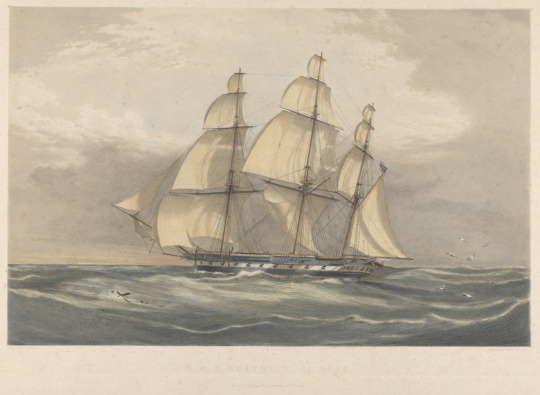
HMS Eurydice, 26 guns, by Rudolph Ackermann
She then took a 20 year break from the sea as she served for about 20 years
as a dockside training ship. In 1877 she was refitted and went to sea as a sea
going training ship. She was just completing a three month training run from Bermuda to Portsmouth when she sailed into history.
The Accident
It was a dark and stormy night on 24 March 1878. The HMS Eurydice ( Captain Marcus Augustus Stanley) was caught in a heavy snow storm off the Isle of Wight. A gale suddenly came up in the otherwise calm night and caused her to founder, Her fate may have been partially due to her shallow draft as she capsized and sank in the storm. She has full sails and gun ports open when she was hit by the storm. One of the survivors recounted the captain gave the orders to reef in the sails, but the crew was unable to do so due to the ferocity of the storm. She heeled hard on her starboard side, where the sea rushed into the open gun ports. Of the 364 men on board, only two survived. Most of those who were not carried down with the ship, they died slowly and agonizingly of exposure in the freezing waters. This was at the time the worst disaster of the peacetime Royal Navy.
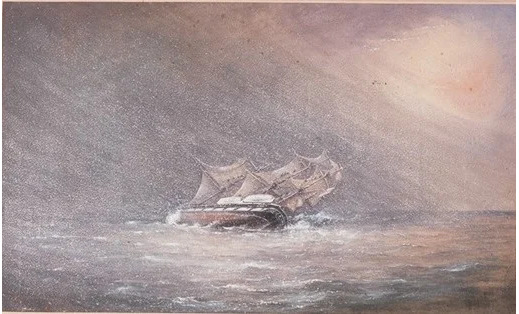
HMS Eurydice struck by a squall off Shanklin, 24th March 1878 by Algernon Yockney
Epilogue
One of the notable people to give witness to the ships passing was a then three years old Winston Churchill, who was living in Flint Cottage in the town of Ventnor at the time. Of the men on board only seven were buried in Lake at Shanklin Cemetery, where there is also one of two memorials. Four others, but only two of them could be identified, found their last rest in Rottingdean St. Margaret's churchyard.
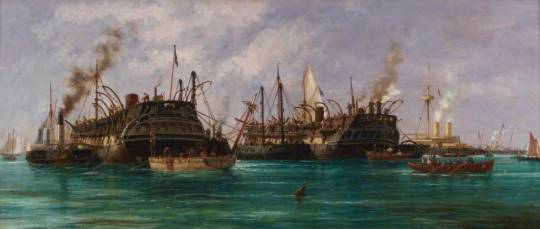
The Raising of HMS Eurydic, by Richard Henry Nibbs
Just one year later, the Eurydice was extensively lifted, but she was too damaged and was soon broken up.

HMS Eurydice under Salvag, by Charles Roberts Ricketts
Unfortunately this misfortune was the prelude for another one which followed two years later, there it hit the HMS Atalanta. She was also a training ship and had already made two successful voyages to the West Indies before she too was hit by a storm and sank. This accident killed 261 men. Later British seagoing training ships were smaller purpose-built brigs.
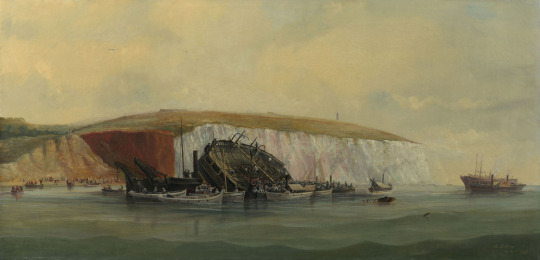
The Wreck of the Eurydice, by Henry Robins

Wreck of HMS Eurydice being towed into Portsmouth Harbou, by William Broome
The Legend
The legend says that the crew of Eurydice doesn't come to rest and whenever it rains very heavily or if it storms she should be seen around Dunnose a cape on the Isle of Wight, which lies west of Shanklin, near the village Luccombe at the southwestern end of Sandown Bay, and she sails around looking for shelter from the bad weather. It is said to have been seen several times. So she is said to have shown herself to the Prince of Wales who took some pictures about the Isle of Wight with a film crew in 1998. Allegedly the crew took some pictures about her. At this point, I'm neutral, with no comments. Should everyone form his own opinion about whether he believes in it or not.
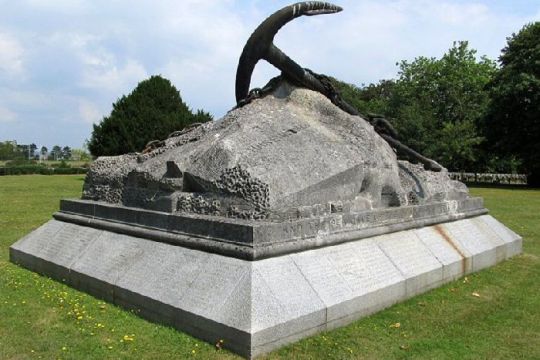
The Eurydice memorial in Haslar naval cemetery, Gosport
There are people who say she won't rest until she has her ship's bell back, which has been a memento in the St Paul's church in Gatten since the accident.
101 notes
·
View notes
Photo

Chingle Hall
UK
Chingle Hall lies just north of Preston, in the small village of Goosnargh, it is one of Britain's oldest and most haunted buildings (it's the oldest inhabited brick building). The house formerly known as Singleton hall was constructed in 1260 by the knight Adam de Singleton. The Hall remained in the de Singleton's family late into the 16th Century. In 1585 the Wall Family who were related to the Singletons, moved into the Hall.
John Wall was born in the Hall in 1620, he studied at Worcester University. In 1641 he became a priest, during the time of the Catholic Reformation it was illegal to practice mass in Britain, Chingle Hall was used as a place of worship by Catholics and had many priest holes and secret compartments were made for the people taking part the mass to hide if the Hall was raided by the kings soldiers. At this time Father John Wall was most active, conducting secret mass on a regular basis.
In 1678 he was apprehended at Rushock Court near Bromsgrove, as he was tendering the Oath of Supremacy. He was taken to Worcester jail, where he was offered his life if he would foresake his religion, but he declined. Brought back to Worcester, he was drawn and quartered at Redhill on the 22nd of August 1679.
His quartered body was given to his friends, and was buried in St. Oswald's churchyard. Mr. Levison, however, secured the martyr's head, and it was treasured by the friars at Worcester until the dissolution of that house during the French Revolution. It is rumored to be buried the Hall's grounds or hidden in the building itself. The Franciscan nuns at Taunton claim to possess a tooth and a bone of the martyr. He was Canonized by Pope Paul VI in 1970.
In 1764 the house was passed to the Farrington family during these times Chingle hall was a hub for zealous religious activity. Great effort was made to keep alive the Roman catholic traditions, cavities were built into walls and tunnels were dug to some of the surrounding buildings as a method of escape.
Once inside the Great Hall, you see the wooden beams going across the ceiling. Some of these beams have strange symbols on them. No one really knew what these symbols were, until some scientists took samples of the wood. They found that the wood was much older than Chingle Hall, and had a lot of salt in them. The wood had actually come from an old Viking longboat. During the 1950s one of the beams spontaneously caught fire, and, just as quickly as it had started, it inexplicably extinguished itself. The smell of wood burning lingers in many of the rooms.
The Different stories of paranormal activity at this location are huge, as is the number of different spirits that reside here. The most popular ghost at the residence however has to be that of Eleanor Singleton. The smell of lavender coming from her old bedroom has to be the most popular experience, but apparitions have also been witnessed.
As for the different ghosts at the building, of which there are many, the most commonly encountered have been listed below:
1 At least 5 monks
2 A Chimney Sweep
3 4 Female Children
4 2 Male Children
5 Eleanor Singleton
6 A Cavalier
7 A Phantom Candle
8 Various entities that have been unidentified
9 Cat
10 Dog
11 Mrs Howarth
12 The “Dizzy Man”
The amount of activity at the hall in massive. Reports include almost every type of haunting, such as apparitions, physical contact, sudden unexplained nausea, feeling of being watched and of unexplained presence's, smells, footsteps, poltergeist activity and electronic voice phenomena. It cant be denied that the claim to the hall being the most haunted house in England isn't made without good reason.
7 notes
·
View notes
Text
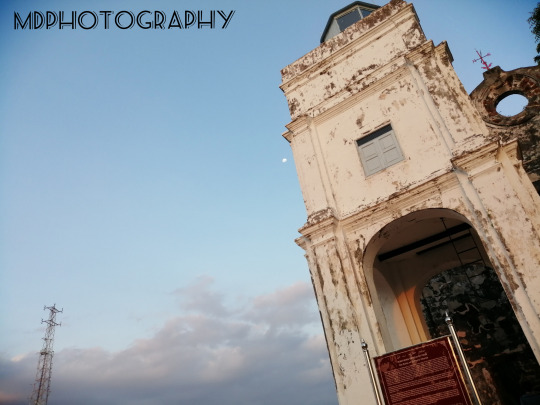
Photo taken by Sylvester D. (Huawei Y9)
HISTORY OF ST. PAUL CHURCH, MALACCA.
The original structure was a simple chapel built in 1521 dedicated to the Virgin Mary and known as the Nossa Senhora da Annunciada (Our Lady of the Annunciation). The chapel was built by a Portuguese fidalgo or nobleman, Duarte Coelho, as an act of gratitude following his escape from a storm in the South China Sea.
The chapel was deeded to the Society of Jesus in 1548 by the Bishop of Goa, João Afonso de Albuquerque, with the title deeds received by St. Francis Xavier. The chapel was then further enlarged in 1556 with the addition of a second floor, and a belfry tower was added in 1590. The chapel was then renamed the Igreja de Madre de Deus (Church of the Mother of God).
A burial vault was opened in 1592 and many people of distinction were buried there, including Pedro Martins, the second Bishop of Funay, Japan.
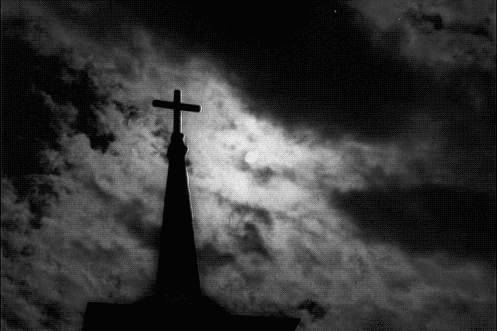
Association with St. Francis Xavier
In 1548, St. Francis Xavier with the help of fellow Jesuits, Fr. Francisco Peres and Brother Roque de Oliveira, established a school in the premises of the chapel known as St. Paul's College. This was perhaps the first school in the modern sense to be established on the Malay peninsula.
Xavier used the church as his base for his missionary journeys to China and Japan. In one of those journeys, Xavier fell sick and in 1552 in Shangchuan Island, China he would die.
In 1553, the body of Xavier was disinterred from Shangchuan Island and temporarily buried at the church before it was finally shipped to Goa. An open grave in the church still exists today marking the place of Xavier's burial.
Reconsecration and abandonment
With the conquest of Malacca by the Dutch in 1641, the church was reconsecrated for Dutch Reformed use as St. Paul's Church also known as the Bovernkerk or High Church. The church remained in use as the main church of the Dutch community until the new Bovenkerk (better known today as Christ Church Malacca) was completed in 1753.
The old church was then subsequently deconsecrated and the structure modified and strengthened as part of the fortifications of Malacca. The nave of the church was then used as a churchyard.
When the British occupied Malacca in 1824, the church was used as a powder magazine and was allowed to deteriorate further.
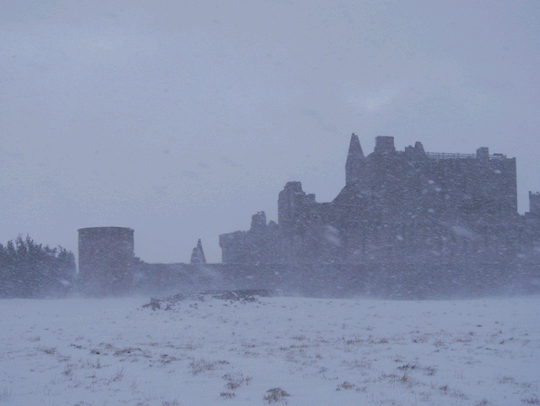
Excavations and later additions
Efforts to preserve records of monuments from the past such as the tombstones found in St. Paul's Church were photographed by the Resident Councillor of Malacca, Robert Norman Bland and published in his 1905 work, Historical Tombstones of Malacca.
youtube
In 1924, the old Portuguese burial vault in the chancel of the church was partially uncovered. Further excavation was done in 1930 by the president of the newly formed Malacca Historical Society, Major C. E. Bone. It was in this period that the tombstones that were scattered around in the vicinity of the church were affixed to the walls.
Photo taken by Sylvester D.(Huawei Y9)
In 1952, a statue of St. Francis Xavier was erected in front of the ruins of the church in commemoration of the 400th anniversary of his sojourn in Malacca. A day after the statue was consecrated, a large casuarinatree fell on it, breaking off its right arm. Incidentally, the right forearm of Xavier was detached in 1614 as a relic.

P/S: Therfore, together us preserve our historical monuments and buildings so our future generations can see how rich our country with cultures from all over the world.
1 note
·
View note
Text
Winterizing Your Outdoor Fountains And Garden Statuary

St. Paul's at Irton is another ancient webpages. There has been a church here since a cross was erected within the churchyard in the 9th a single. The current Victorian building is Grade 1 listed, and has some remarkable William Morris windows.
Unfortunately, when tượng đá thánh giuse thợ mộc get tough individuals are down and out, morale suffers and hope is isolated. Spirituality goes out the window and remorse is one area of prior. The consequences of this going downhill are often drastic - crime increases, stress increases, and happiness decreases. Precisely what a way enter in the winter holiday!
youtube
When the happy couple thinks the incident is over, the fiercely beautiful creature rises from her chair and questions experience . of her awakening. God found Adam and Eve after their incident and questions them of their awakening as well. "The Lord God said for the woman, why did you must do such a specific thing?" (Genesis 3:13) The beautiful creature informs Digory that he or she is not of royal blood and wonders how he arrived there. Polly says it was by magic, and when Digory agrees she figures that he is not a magician, but has traveled on another's magic. Uncle Andrew.
The Stone Table played an important part in the story and references another essential person in biblical details. "Moses . wrote on top of the tablets the phrase of the covenant, the ten rules." (Exodus 35:29) Moses brought the stone tablets containing the Ten Commandments folks to live and eat. When Aslan rises from the dead, to the front stone statues of Susan and Lucy, and breaks the Stone Table it's a symbol of the old, cruel ways of the past being shattered and birth of the new, lighter times that lie for it.
You may decide you want to know trade instead of going to college. However, masonry is on the list of most creative and artistic of all of the trades. And need for that father balanced in order to individual be a mason, you'll need to be able to lift, prepare intricate designs and execute plans full your careers. It is likely that some top work that you'll be doing will be similar special of an architect. Opportunities are expected to be good in long term. According to the Bureau of Labor, median hourly wages of brickmasons and blockmasons might 2008 were $21.94.
Without visiting San Diego you cannot complete your holidays as it is well renowned for shopping additional exciting holidays. The beaches here are ravishing and scintillating. The famous Balboa Park is also an eye catching attraction for a San Diego Zoo.
Cumbria lays claim towards smallest church in Britain, although motivating disputed. The candidate is E. Olaf's, at Wasdale Head. It certainly a tiny, even by common of the countless small sandstone churches in the market. Its antiquity is suggested by the cover beams, that are said to come from Viking ships. Street. Olaf's is surrounded by a splendid stand of yew trees in an otherwise bare valley landscape.
0 notes
Text
Aftermath: Art in the Wake of World War One
Aftermath: Art in the Wake of World War I
Tate Britain
Until 23rd September 2018
Currently on at the Tate Britain is Aftermath: Art in the Wake of World War One. Marking the 100 year anniversary since the end of the First World War 'Aftermath' explores the impact that this infamously great war had on British, German and French art; exploring not only the physical but the psychological scars that this time left on Europe and its artists.
World War I (often abbreviated to WWI), also known as the First World War, was a global war that originated in Europe and lasted from 28th July 1914 to 11th November 1918. It was described as the 'War to End All Wars', with more than 70 million military personnel mobilised in one of the largest wars in history. Over 9 million combatants and 7 million civilians died as a result of the war; it was one of the deadliest and gruelling conflicts in history, and precipitated major political changes. One of the triggers for the war was the assassination of the Archduke Franz Ferdinand of Austria by Yugoslav nationalist Gavrilo Princip in June 1914. As a result international alliances formed over previous decades became entangled and involved in the conflict. Within weeks the major powers were at war, and soon it spread across the entire world. After the war art was used in many ways, from the building of public memorials to documenting its destructive impact both socially and on the land itself. This heartbreakingly fascinating and moving exhibition shows how artists reacted to the memories and life the war created.
William Orpen's 1918 'Zonnebeke' shows a dark and gloomy scene, displaying dead bodies strewn about the place, almost like dolls tossed aside by children done playing with them. Orpen drew on his own experiences elsewhere to express the horrors and destruction of war. The scene is truly horrific, almost causing viewers to feel slight guilt as they can't help but admire the beauty in the piece that contains such awful images. The horrors of the painting are even more unimaginable when viewers are reminded that it is not a scene taken from one's imagination, but rather one that was, sadly, a very real daily view for so many people. However, amongst all the darkness and dismay, Orpen has painted a small crack in the dark black clouds, where a blue sky peeps though, offering just a glimmer of light and a symbol of hope amongst all the death and destruction.
One of the most inspiring artists featured is British artist Paul Nash. Immediately after the war Nash painted 'Wire' in 1918. Showing hoards of dead trees and nature, Nash documented the sad reality that was not only human life but all life was taken as a result of the war. Every inch of the painting shows destruction of the worst kind, from charred, blackened trees with barbed wire wrapped around them symbolising mutilated bodies, to the soil that once held life, now burned, blitzed and devoid of any living thing.
Nash grew up in Buckinghamshire, where he developed a love for the land. Nash found much inspiration in landscapes with elements of ancient history and the artworks he produced during WWI are some of the most iconic images of the conflict. Shortly after the start of the war Nash reluctantly enlisted as a private for home service. Nash's duties, which included guarding the Tower of London, allowed him time to continue drawing and painting. In December 1914 he married Margaret Odeh, an Oxford educated campaigner for Women's Suffrage. He then began officer training in 1916 and in 1917 was sent to the Western Front as a second lieutenant. Based at St. Eloi on the Ypres Salient Nash has a reltivley quiet time. The desruction to the land was tremendous, however Nash was overjoyed when he saw that with the arrival of Spring the landscape was starting to recover from the damage inflicted on it. In May 1917 Nash fell into a trench and broke a rib and was sent back home to London. A few days later the majority of his former unit were killed in an assault. Nash considered himself incredibly luckily to have evaded death and adopted a new outlook on life. In November 1917 Nash returned to Ypres Salient as a uniformed observer, at this point however the war in this location was three months old and Nash often found himself under shellfire. Nash was horrified to discover the that the landscape he returned to was very different to the one he had last seen in Spring. The ditches and small canals had been all but destroyed by the constant shellfire, months of incessant rain had led to flooding and miles of deep mud. Nash was outrages at this desecration of nature, believing the landscape no longer capable of supporting life or recovering. This realisation led Nash into becoming angry and disillusioned with the war. Nash's anger, although painful, was a brilliant creative stimulus which led him to produce dozens of paintings a day, working with an angered frenzy that caused him to begin taking great risks to create his art which took him to the front line trenches.
Nash's 'Landscape at Iden', painted sometime after the war finished in 1929, shows a surrealist farm yard setting. A huge pile of logs to one side represents the piles of dead soldiers from the war, while the snake coiling around the fence symbolises the rod intertwined with serpents that was held by Mercury as he accompanied the dead to the underworld in classical mythology.
Many paintings show the graveyards that were created almost as monuments to the dead soldiers. They show the identical graves all in rows, stretching far and wide into the hundreds of thousands. These mass graves show the mathematical perspective of the carnage and body counts that the war bought. Christopher Richard Wynne Nevinson's painfully ironically named 'Paths of Glory' shows an unflinching depiction of soldiers whose bodies have been left to rot in waste land. The title is taken from the 1750 poem by Thomas Gray, 'Elegy Written in a Country Churchyard', “...the paths of glory lead but to the grave”.
This exhibition serves as a painful reminder to viewers that death didn't just happen on the front lines of war, but that it was taken home to the citizens and other that had witnessed the horrors of war and could not escape them. Such is the case with Wilhelm Lehmbruck who sculpted 'The Fallen Man' in 1915-16. The statue shows a man on all four, begging, pleading, distraught, devoid of anything but hopelessness. Lehmbruck could not recover from the horrors he had seen and experienced at war and ultimately he committed suicide.
One thing each war artist had in common was the ability to show their revulsion of the war. Artists from all countries, some opposing, all showed the horrors as they truly were, there was no propaganda from any sides from any self respecting artists. Many artists also showed the dehumanising of soldiers, as they were all in the uniforms stood in rows waiting for death; each soldier just a number in the grand scheme of things, instead of a son; a father; a husband; a brother, just wanting to go home to the lives and their families.
Conrad Felixmüller's 'Solidet in the Madhouse I & II' are representations of the psychological effects the war had on people. The use of sharp edges, distorted forms, and twisted, confined bodies represent the feelings anxiety and pain are a result of Felixmüller's time spent in a psychiatric hospital after he refused to join the German army after being drafted. He spent four weeks in the hospital and during this time he developed this distinctive fragmented style of art.
Many people during this time took to religion, including artist Winifred Knights, whose 'The Deluge' shows citizens fleeing form a great flood in reference to the Old Testament flood. It shows people with sheer terror in their faces, as the flood is used as a metaphor for conflict and bombing. The painting exudes a dramatic sense of panic. Pablo Picasso also used religious references in his works after the war. 'Family by the Seaside' includes Christian imagery of the pietà, the dead Christ moourned over by the Virgin Mary. His painting shows a mother and child lamenting over a dead fathers body, displaying the melancholy that remained even after the war.
Dorothy Brett's 1916 'War Widows' shows a group of women all dressed in black, surrounding a central woman who is pregnant. This painting is a result of the enormous death toll that affected the women of the war. Although not directly in the heart of the battles the women and children were deeply affected, suffering constant worries, pain and loss. This painting gives viewers the opportunity to reflect on the social bonds of bereaved women and how the war negatively impacted the next generation.
Tucked away in corner of this exhibition is an area of colour and hope showing paintings of golden fields, and vibrant green countrysides that remain beautiful and untouched by war. These thriving areas, full of colour and bountiful life, offer a quite life away from the cities. Showing the hope and wonders to come after the war. They show the peace that so many longed for.
The painted images of twisted, mangled bodies that lay in the blackened, hellish landscapes of senseless destruction do not do justice to what was experienced during the war. As viewers to these tremendous pieces of art we can not even begin to comprehend or imagine how life was during this time. These artists have given us these small, heartbreaking glimpses of life during the war, creating pieces of art that though horrifying and disturbing are beautiful in a twisted way.
3 notes
·
View notes